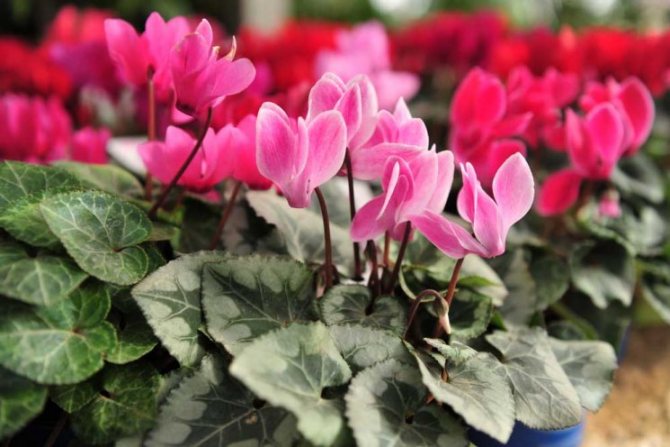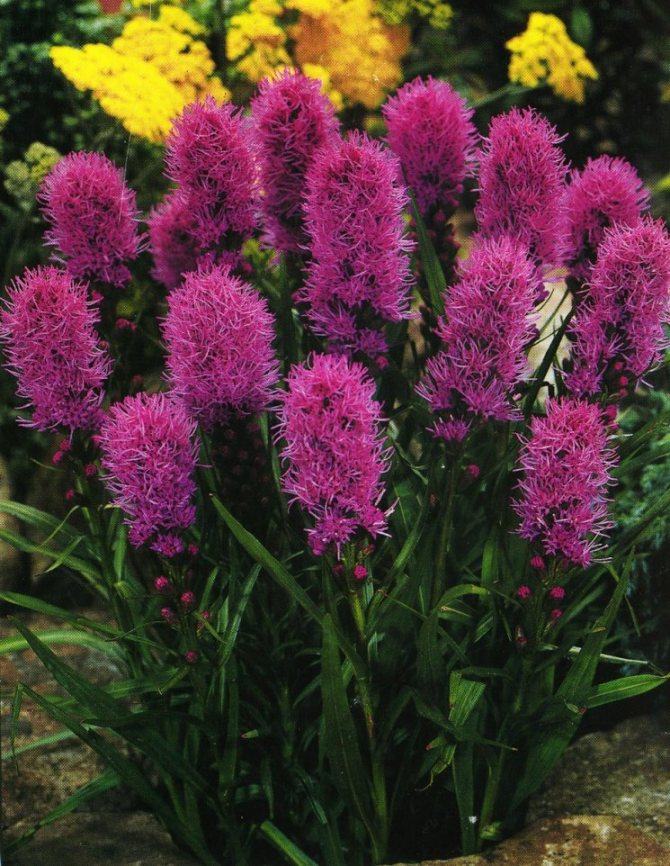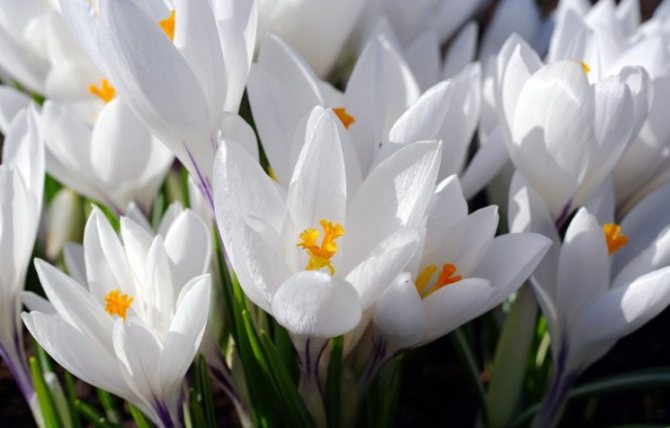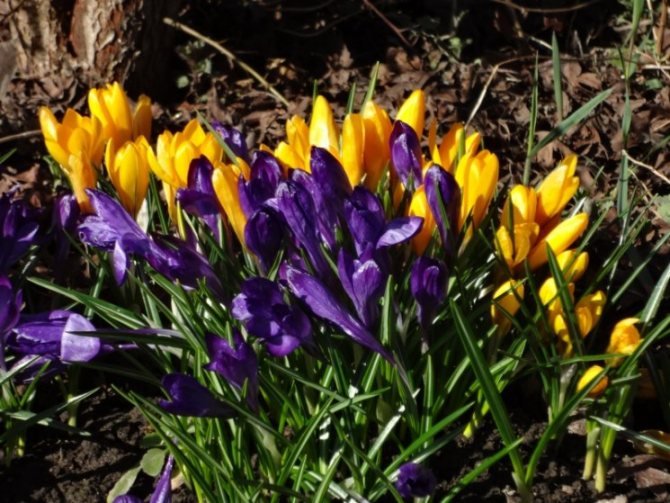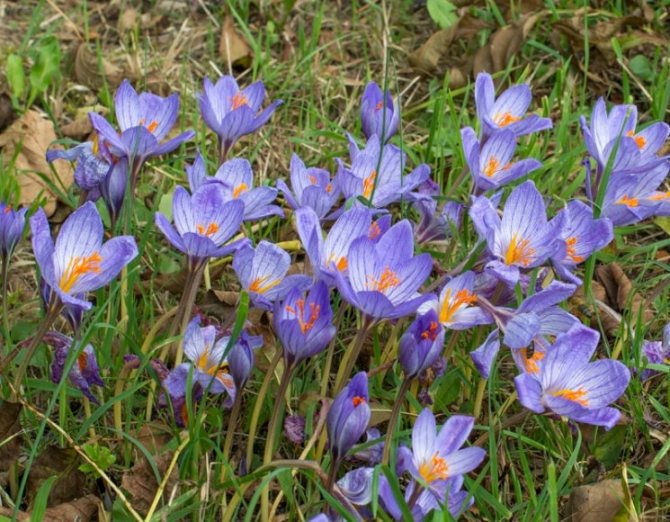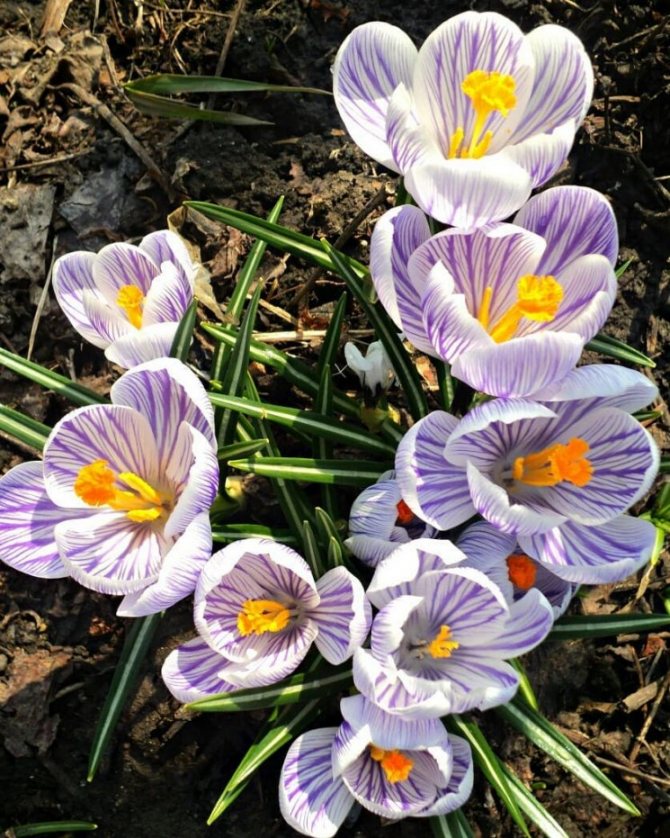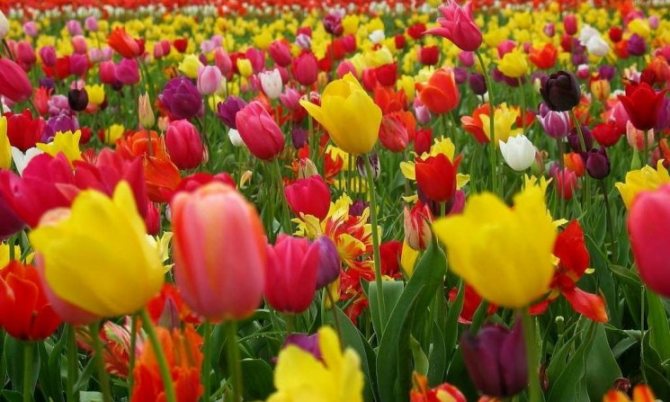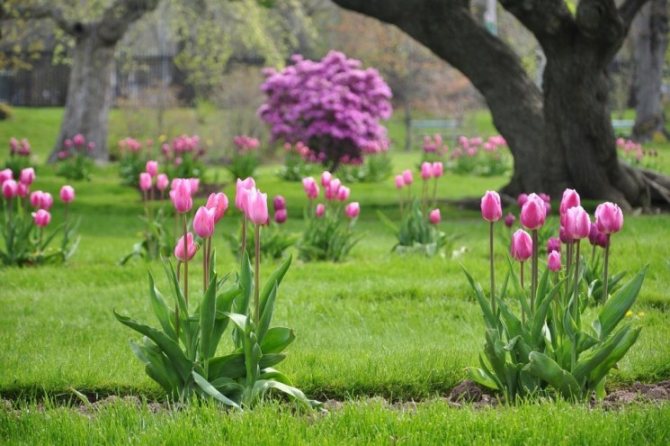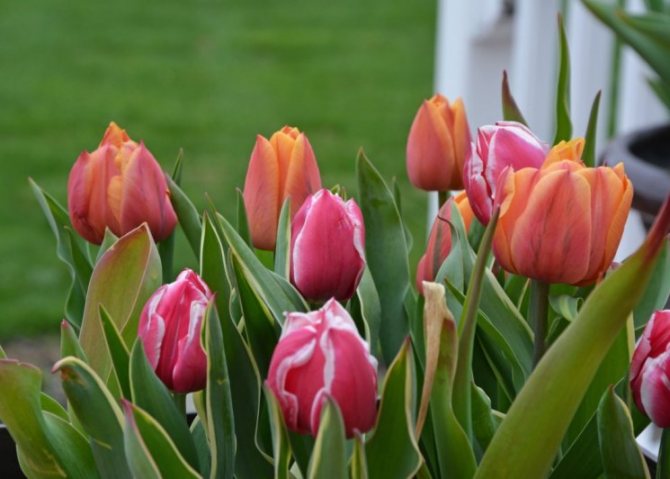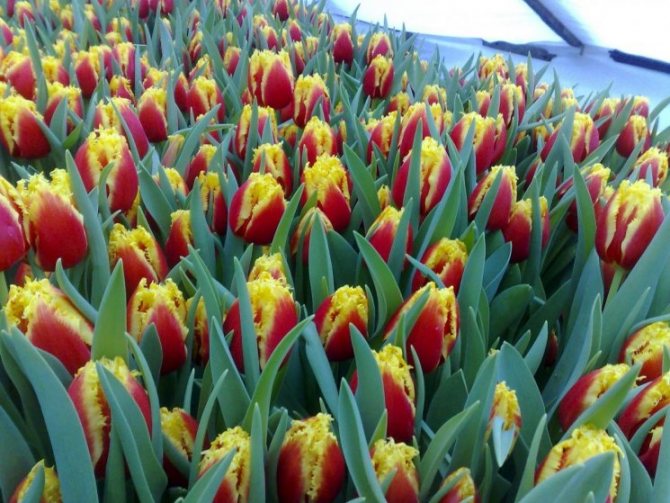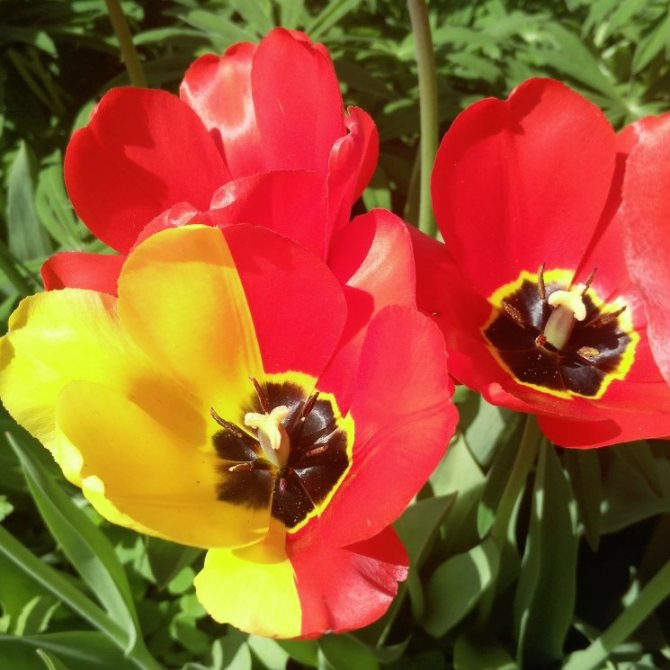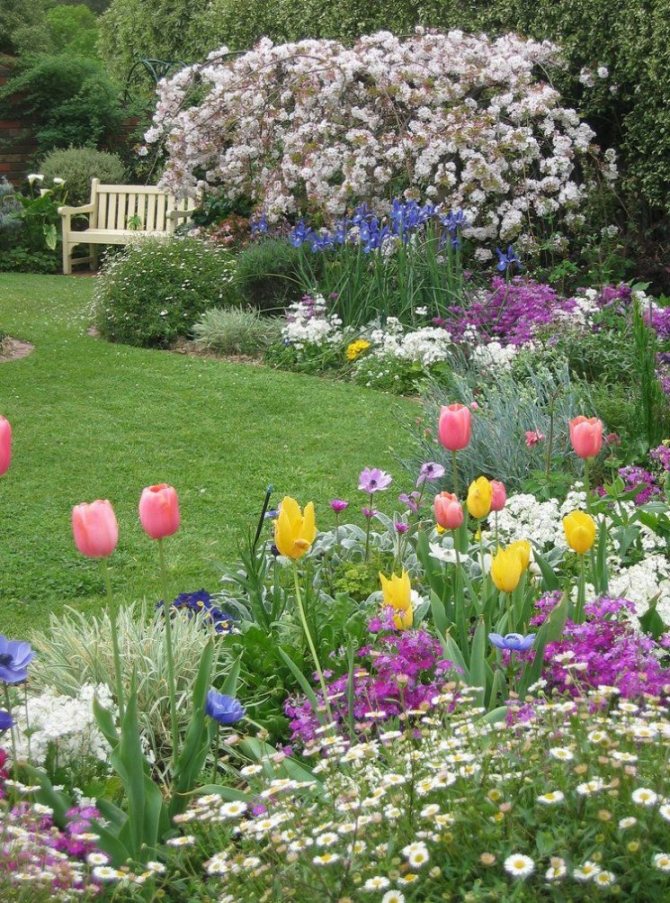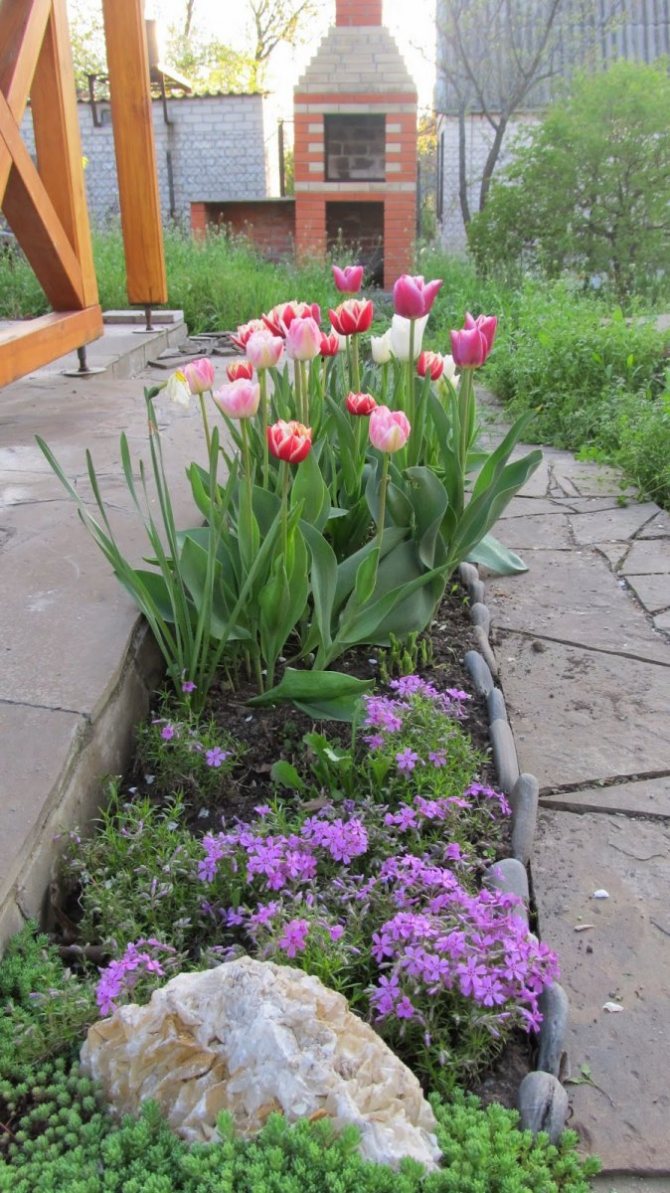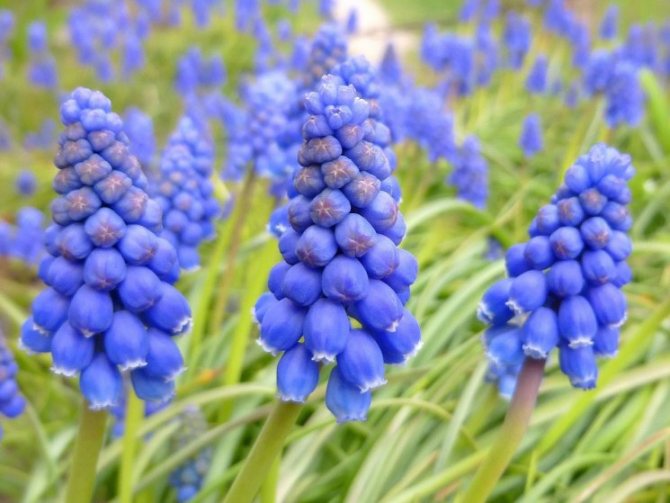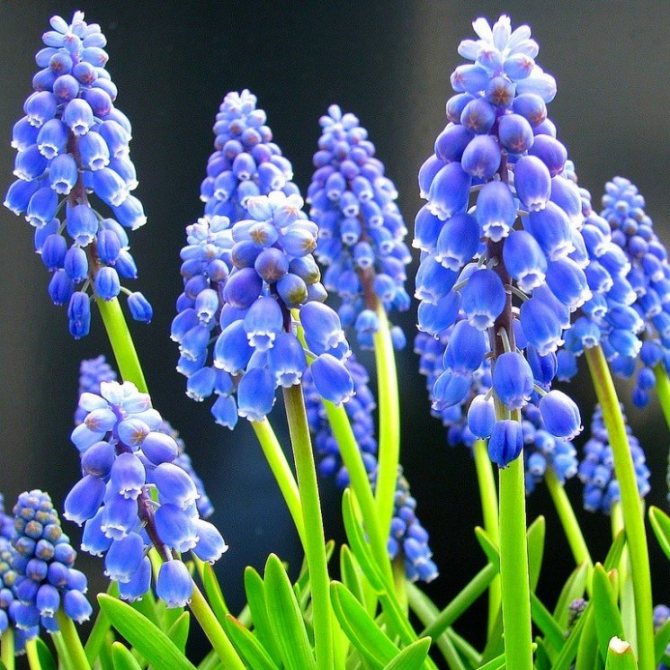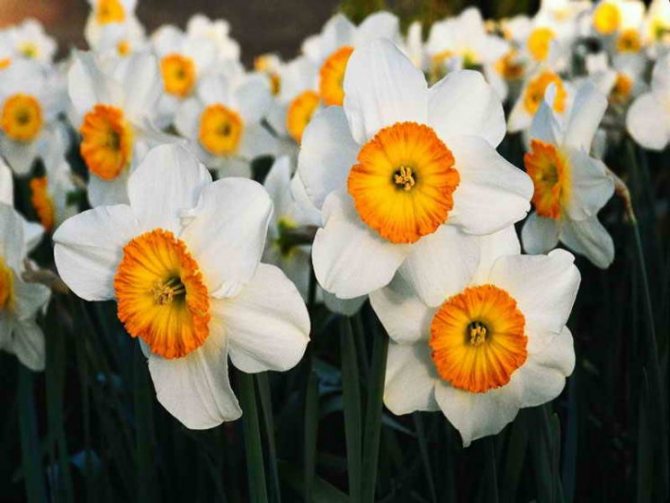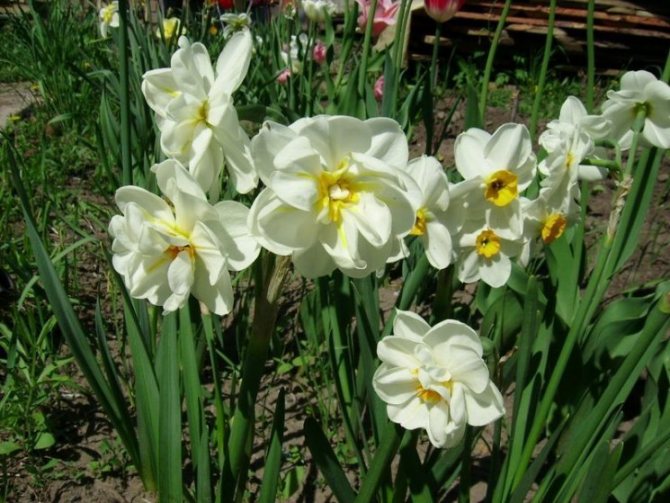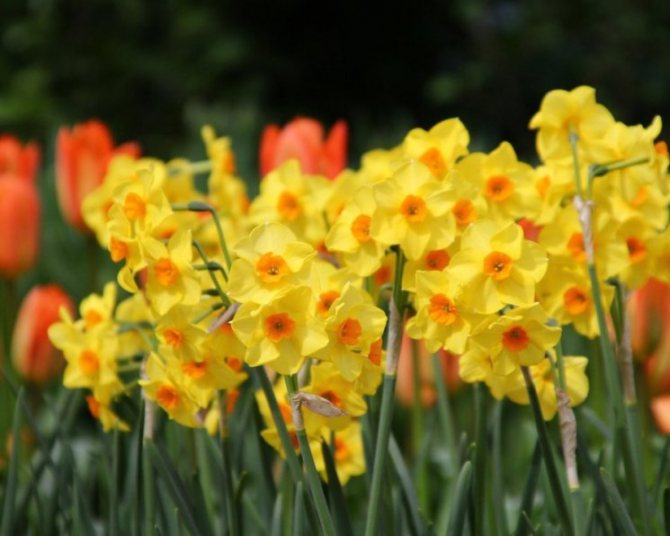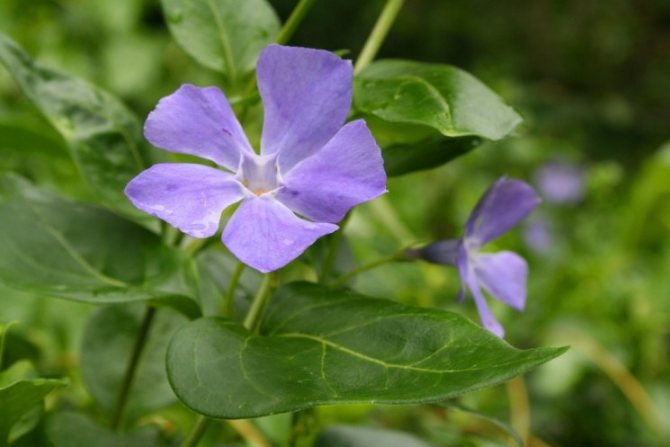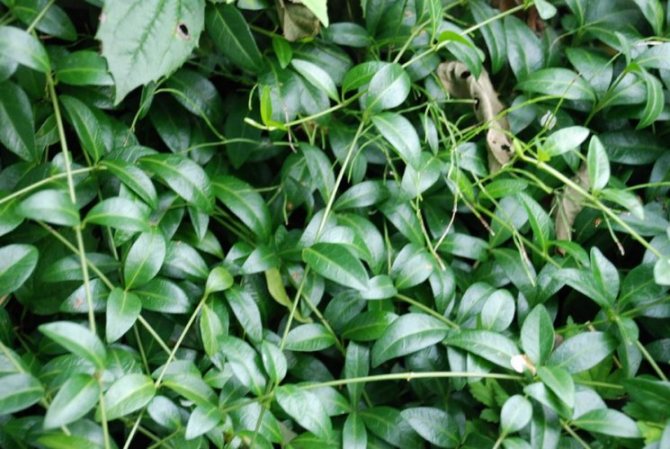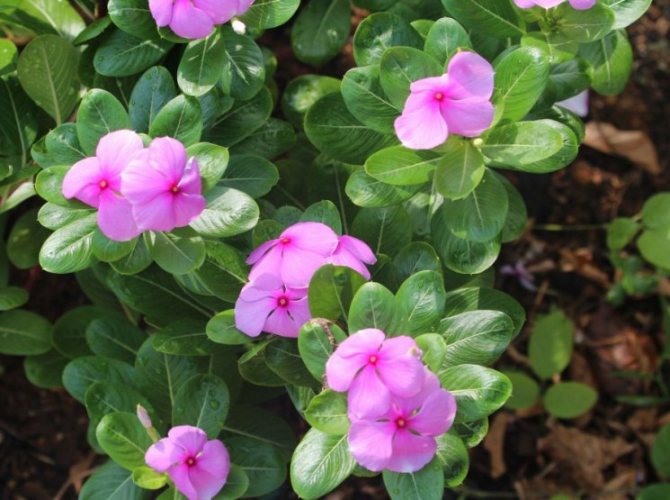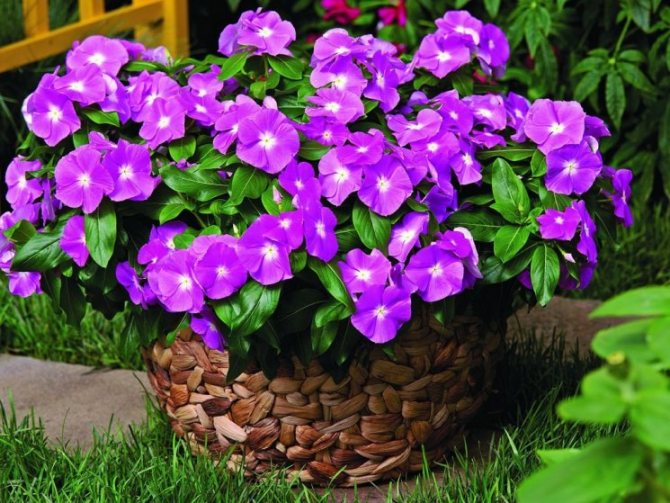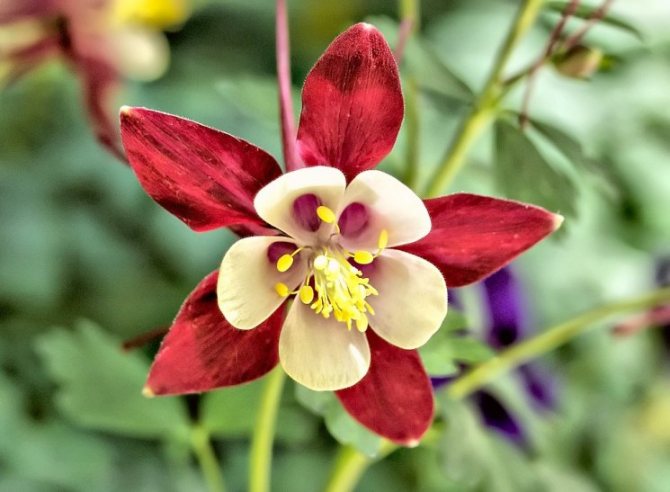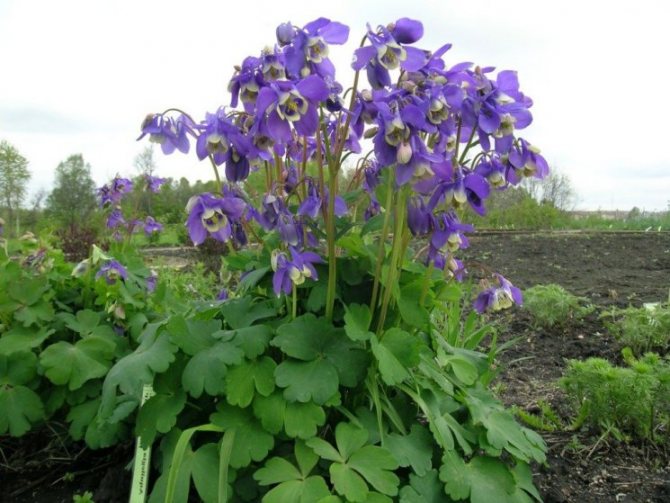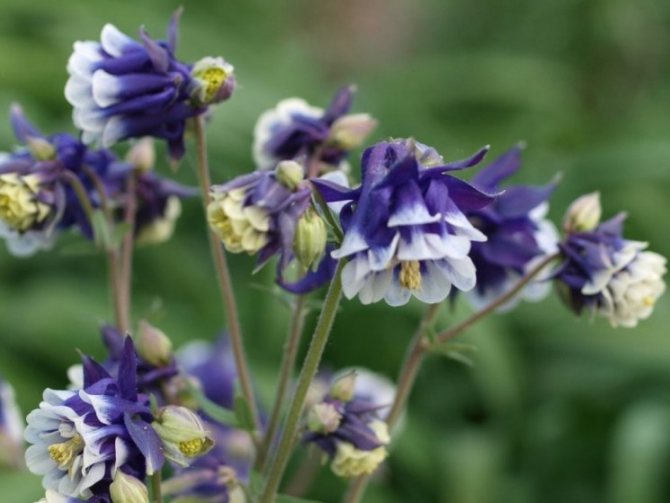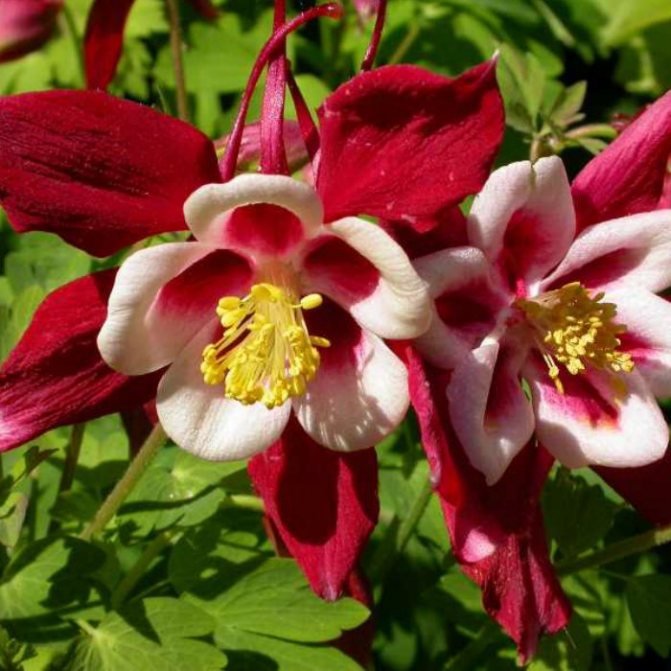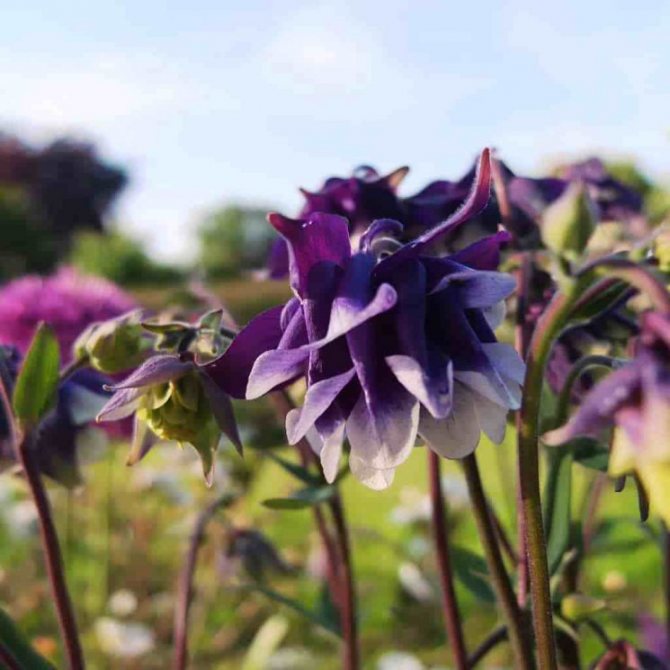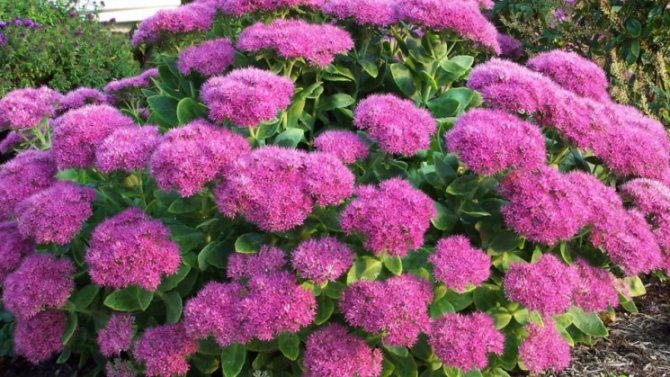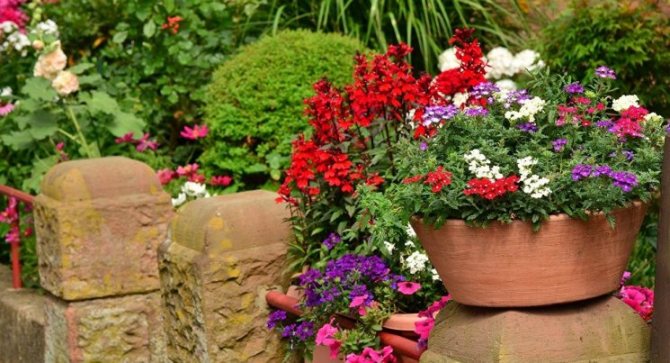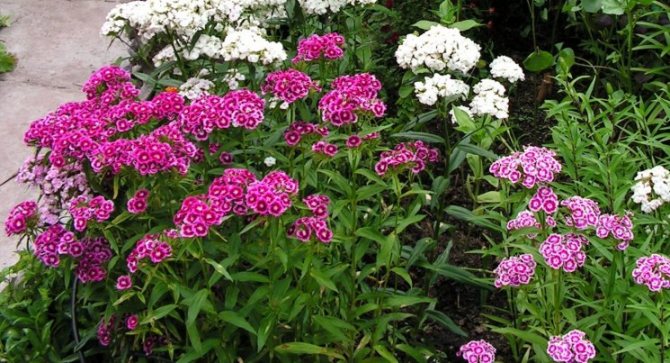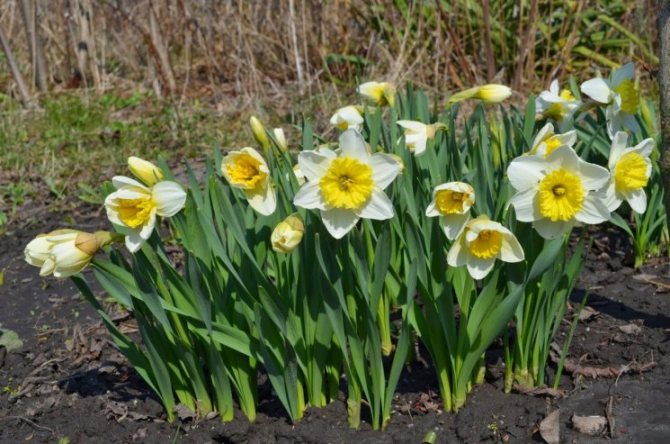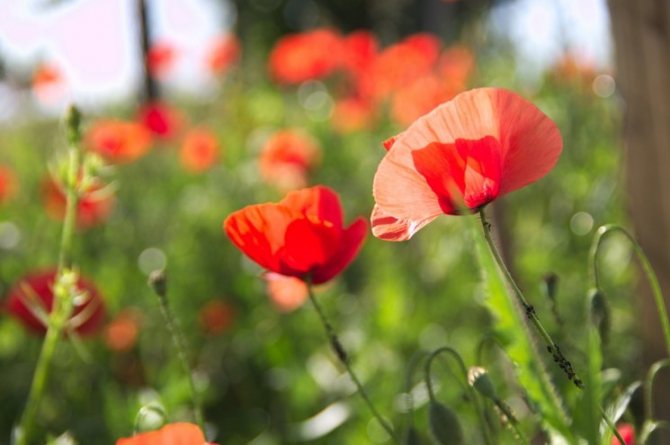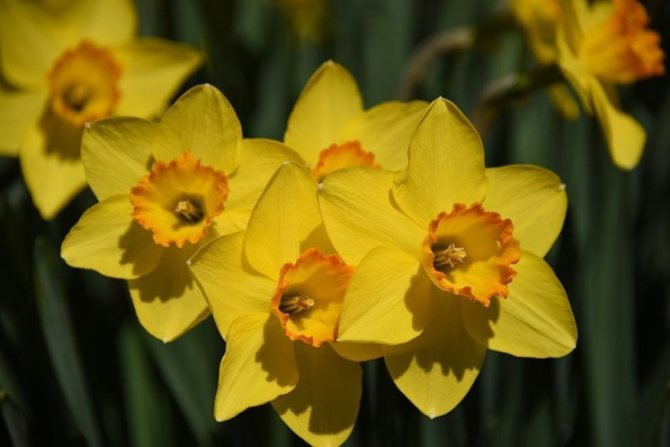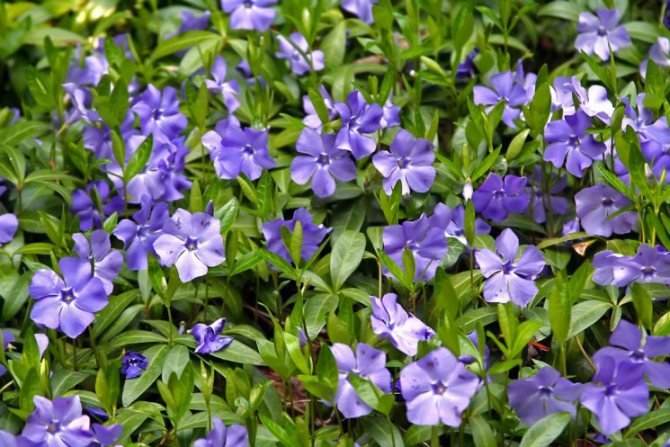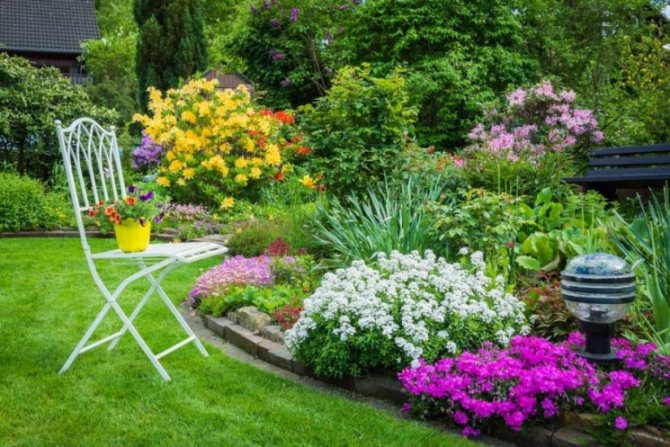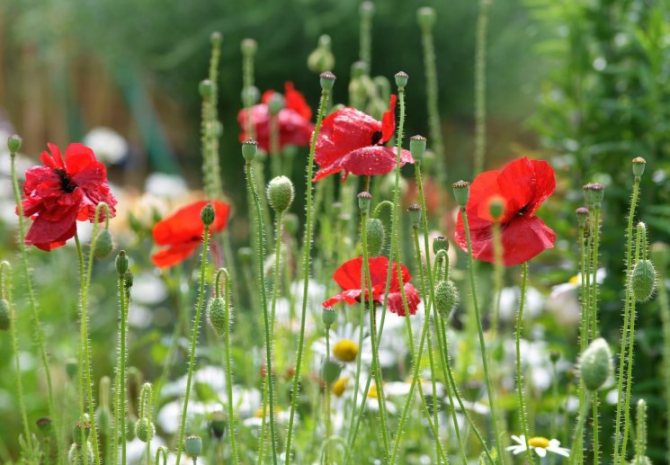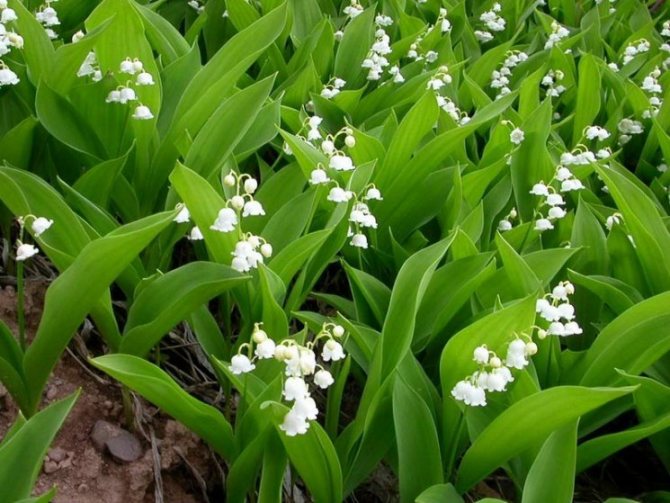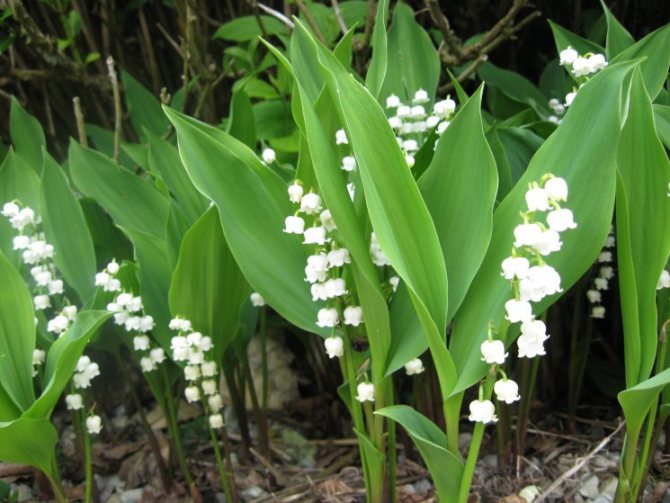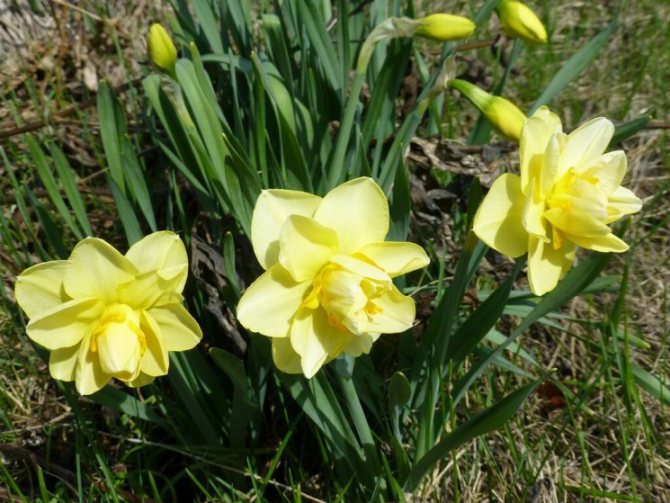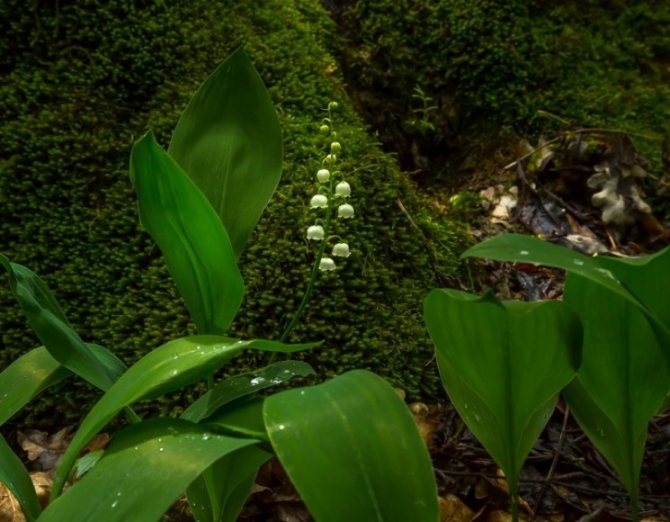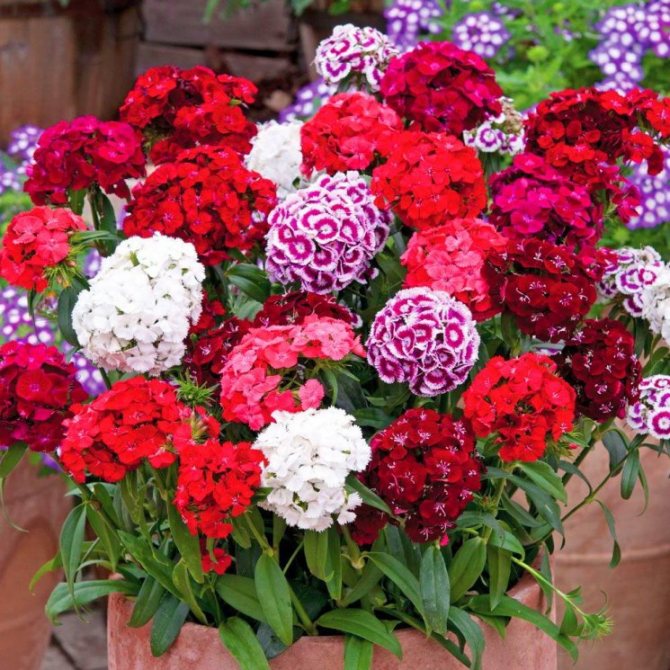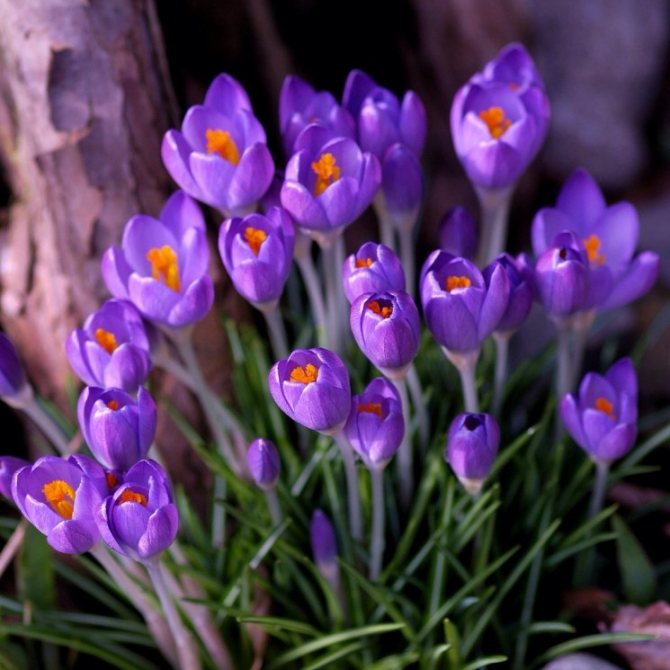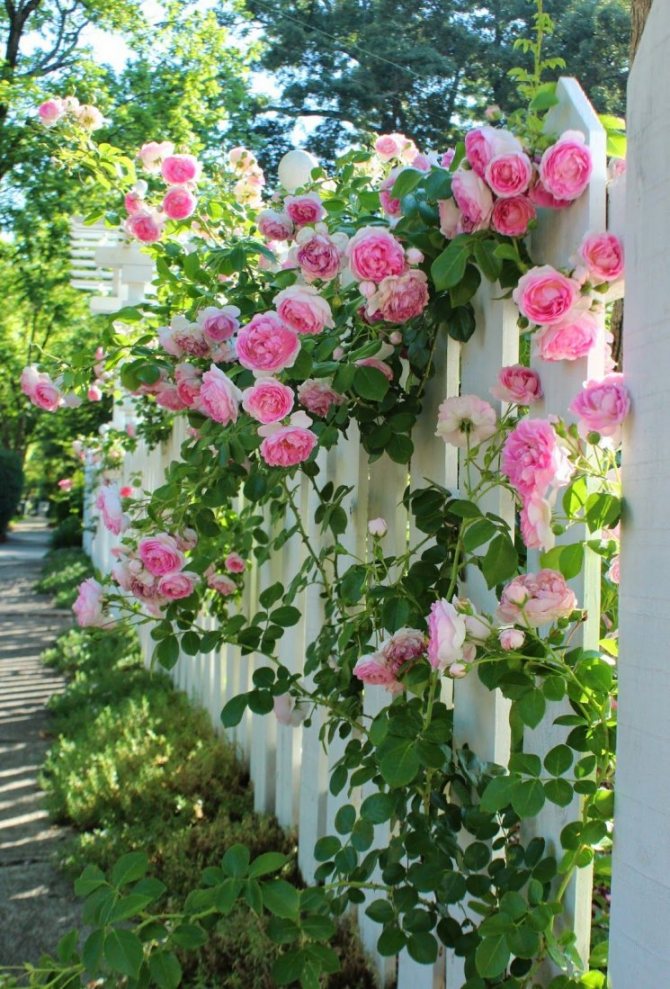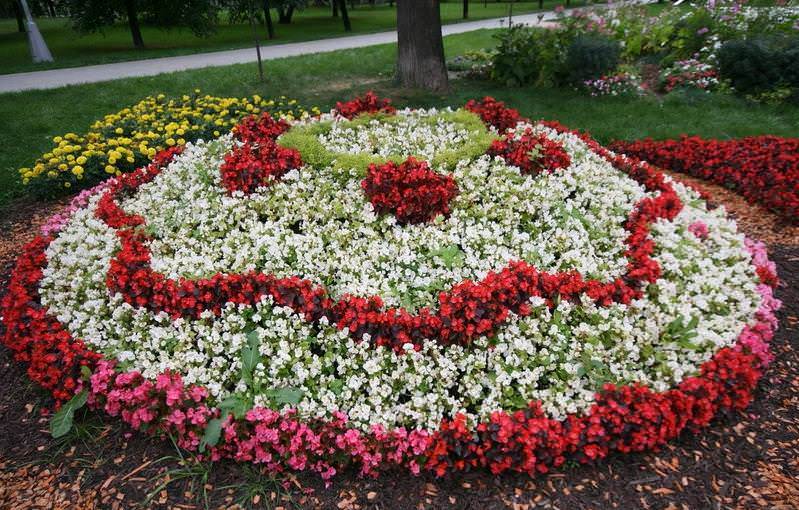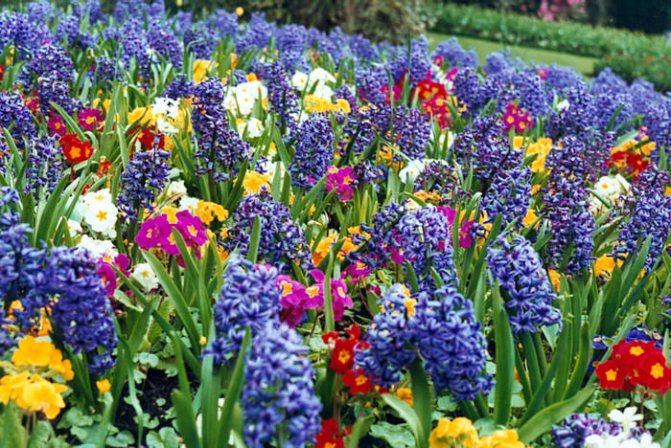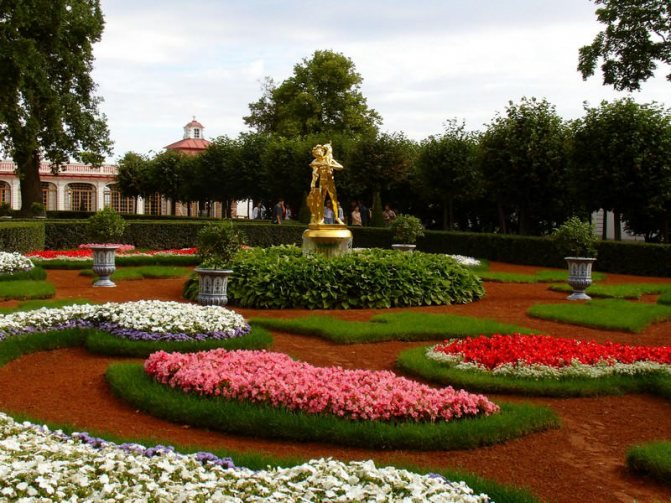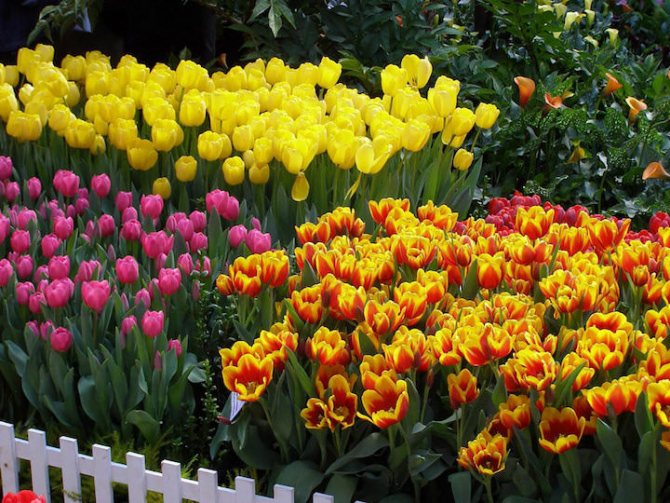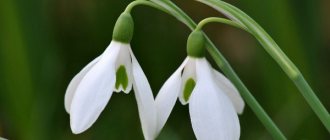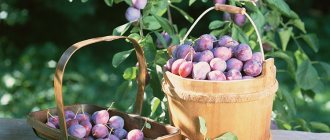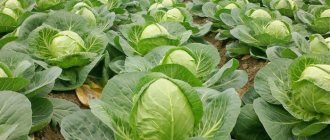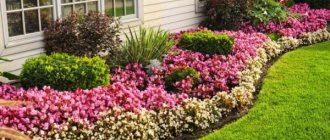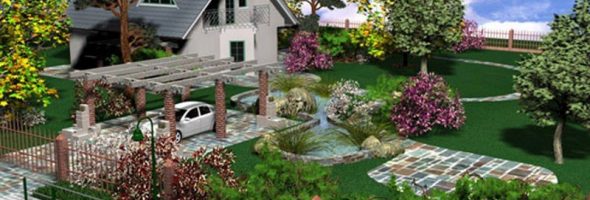
Added by: Evgeny Udaltsov on September 2
So we got to the point when it's time to move on to the story of how to properly plan your site, or rather its garden part, where you will grow both edible plants and various flowers, herbs and fruit trees with shrubs.
Of course, as you could learn from previous articles, the first prerequisite for planning is to collect information about the illumination of the site and its location relative to the cardinal points. Once this information has been collected, you can proceed to the first strokes.
- 2 Take on a pencil (site layout - video)
- 3 We give nobility
- 4 Colors in the garden and in the house
Bulbous
In winter, plants of this type are at rest, in the autumn they strengthen. When the snow completely melts, the first inflorescences appear.
Bulbous flowers for the garden dive into the beds in the fall. When planting, be sure to feed them. If the soil is sufficiently well fertilized, then they can grow for 5-7 years without changing the place.
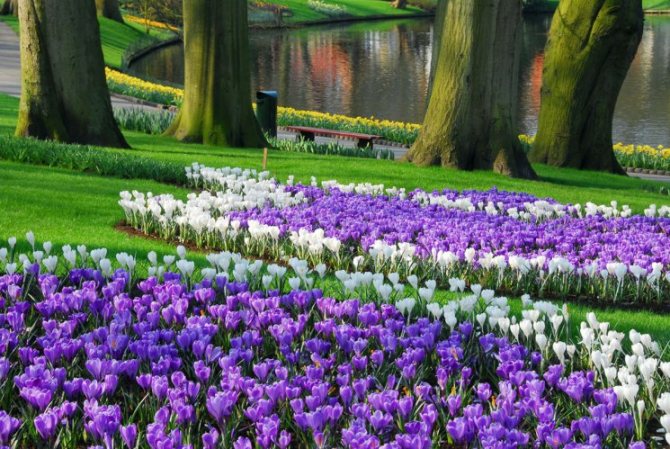

Quite often, when disembarking, containers with a removable structure are used. A deepening is made in the ground and a container with sowing is placed in it, sprinkled with earth on top.
The first sprouts of bulbous need not be watered, they are content with moisture from the melted snow. Watering tulips and hyacinths is carried out as needed - when the soil is dry. In no case do not fill young shoots, otherwise they may rot and die.
Bulbous ones are great for decorating a garden, they look beautiful and are unpretentious in content. After the end of the flowering period, they are left in the ground, and the next season, you can also get "babies" from the bulb. Bulbs are planted both individually and in groups - in flower beds, along curbs and paths.
Take on a pencil (site layout - video)
Everything is on record - all landings and disembarkation points can be recorded At the end of the season, it will be possible to take stock of the observations and decide which plants to work with next and which to replace.
After working on planning your site, you should have a plan with a picture of buildings and dividing the site into zones. Find out which parts of your garden are always lit by the sun, which are in partial shade, and which do not see the sun at all. The more detail you have on your plan, the better. The main task now is to determine the places for planting plants and think over what kind of plants you will plant.
There can be many variations on the theme of planting. A house, a fence or a pergola can be landscaped with vines, pots on a stand, pots or other hanging containers can be ennobled with ampelous plants. If there is a place for a flower bed in front of the house, it can be planted with a variety of flowers. So from the window of the living room or the terrace you and your guests can admire the variety of natural colors. It is not at all necessary to plant only food crops in the garden.Many are limited to flowers and herbs, while others generally prefer to plant the entire plot with fruit trees and a lawn.
Crocuses
Multicolored crocus corollas delight with their bright colors. There are even striped varieties. They appear literally from under the snow cover. At a height of 7-15 centimeters, they bloom from mid to late spring. When the inflorescences wither, the plant goes into a dormant state.
Bulbs are traditionally planted in late summer or autumn. Crocuses like a lot of light or at least partial shade.
Crocuses are great for combined plantings. Against the background of stones and alpine slides, they look just great.
Transportation of seedlings by car
- It is better to bring young (small) heels than one adult.
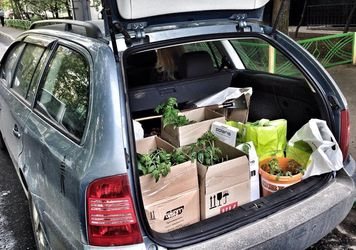

- Plants must be strong and healthy.
- Before transportation, you need to plant the plants in a light soil mixture (put in a box, bag or jar with drainage holes, and sprinkle the roots) and let them take root for several days. It is advisable to thin out the leaves so as not to provoke the development of mold.
- On the road, it is advisable to give the plants the opportunity to receive at least a little light and air. And avoid overheating. Water as needed.
- Upon arrival, a couple of weeks of adaptation in partial shade are required.
Based on the book
Tulips
The most popular flowers at their summer cottage. They are distinguished by their unpretentiousness and have thousands of different attractive varieties. However, few people know that there are several types of them, which differ both externally and in terms of flowering.


Skillful selection of varieties can help to completely decorate the dacha with tulips alone. Moreover, they can be 10-50 centimeters in height, so it will not be difficult to create an interesting composition.
It is better to plant tulips in autumn, in loose, nutrient-rich soil. Plants need constant watering. The first bloom can be seen in March. By the beginning of summer, as a rule, even the latest tulips are already withering.
Features of planting vines
When planting vines, the main thing is to put a durable and strong support BEFORE you plant the vine. Ropes, sticks and frail wires are not considered support.
Remember - without a STRONG support, many vines will NOT grow in height. Instead of several powerful shoots (the norm on the support is from 1.5 to 3 meters in the Middle Strip and up to 5-7 meters in the South) vines without support begin to bush and "drive the growth", which does not ripen by autumn - which means strong freezing in winter, weak flowering and fruiting. It is because of the cultivation of vines without capital support or poor maturation of the "bush" it is often recommended to bend down and cover completely frost-resistant (on a support !!!) plants for the winter, for example, lemongrass or actinidia kolomikta.
When planting, the liana is IMMEDIATELY fixed on a support. The best way is to carefully and tightly wrap the shoots around the support and securely fix the ends of the shoots on it. To do this, you can take neat plastic clips or wire. Try to fix exactly the ends of the shoots. The fact is that constrictions at the base (closer to the root) also cause growth of the growth.
Muscari
The dacha muscari flower is low - 10-20 centimeters. Its stems are strewn with small bell-shaped inflorescences. In another way, the plant is called mouse hyacinth. Belongs to a variety of decorative bulbous. It looks quite modest and unassuming.


A plant planted under trees or bushes will delight you with its charming flowering for many years. At the same time, muscari tends to grow. It is better to plant it in the summer, when the inflorescences are already beginning to wither.
Planting is carried out in early autumn. In order for muscari to accumulate their strength, you need to monitor the condition of the earth - it must be well warmed up and not wet.
Planting plants - the main rules
- How to plant plants correctly - they should not be planted deep (deeper than it grew in the old place). Even if the climate in your garden is arid and sharply continental. The place of transition of roots into stems should be on the surface of a small mound. The best roots grow right under the mulch! And then they themselves go to the sides or in depth. For those whose climate is still completely continental and the soil freezes deeply - you just need to make a rule 4 (To mulch) 2-3 times.
You can't bury the plant deeply or dig huge holes. The hole should be of such depth and width that the root ball rises above the surrounding surface by a few centimeters or is at the level of this surface. If there is no coma, then the hole is not needed (!!!), if the roots are not completely vertical and not very rigid. Very tough vertical roots require a narrow hole with a dense vertical wall.
- It is necessary to ensure tight contact between roots and soil - to ensure a reliable flow of moisture through the capillaries. Remember that there are capillaries only in dense soil! Just do not crush the roots from diligence. The bottom of the hole may not be very wet, but the soil that touches the roots is VERY. Ideally, pat the roots lightly with a thin layer of moist soil (you can take it somewhere else). Not entirely aesthetically pleasing, but effective. It's more effective than standing with a hose and praying for a week ...
- Bare roots must not be dried. You need to work quickly. You can take your time only if it is drizzling (or sleet) during landing and there is no wind at all. And if the weather is “good” (warm sun and gentle breeze) - know that active small roots can withstand “good” weather for only a few minutes. If the weather is “very good”, they dry out in a few tens of seconds. And then the plant will have to grow new roots and root hairs.
- Mulch. Abundantly, so that the hills were covered with mulch in a layer of several centimeters, and the "valleys" and "lowlands" between the hills were filled with mulch ALWAYS with the hills. That's it, now you still need to water. Straight on mulch - and more abundant. Done!
- 5,6,7 - all other wisdom described in the "special literature", do NOT need to.
Pour mineral fertilizers, ash and lime into the pit Do not - increase the concentration of salts and can burn the roots. If you really need to feed, it is better to do this on mulch and later, when the plant takes root. Ideally, in a few steps.
Pour the drainage layer (crushed stone, sand and broken brick) to the bottom of the pit Do not - there is little use from it, and capillaries are NOT formed through the "drainage" (until it is washed with soil). Think about where the "extra" water to go when the "drainage" is full?
Pour organic fertilizers (compost, humus, peat) into the pit Do not... That is - organic matter is needed! Even - very much needed! It's just that you don't need to go into her hole! The full effect of it will be if you use it as the bottom layer of mulch. That is - organic matter - ON the soil and UNDER the mulch. Deep in the planting pit, organic matter slowly and "incorrectly" decomposes, sometimes emitting harmful gases (simply rotting). And when it completely rots, the planting site subsides and the plant ends up in a hole. And he has to adapt to the changed conditions, and in fact it has just got used to a new place. Plants prone to damping may not get used to the second time.
Daffodils
In second place in popularity after tulips. They bloom from April to the very end of spring. They are remarkable not only for their sunny colors, but also for their rather pleasant smell.
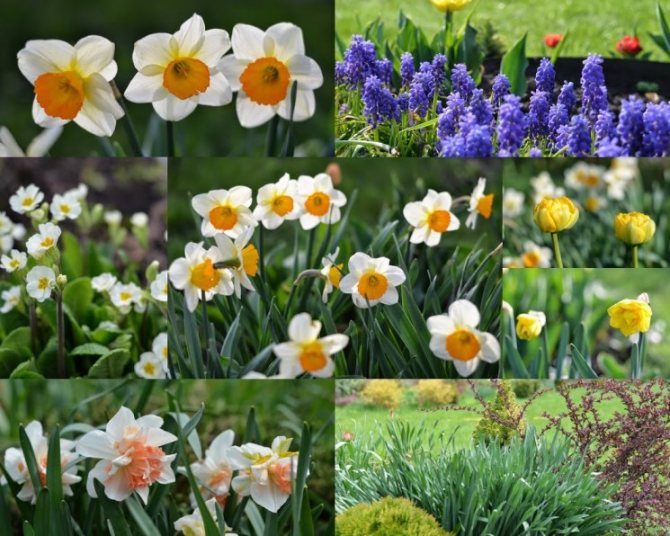

There are both simple and terry. They love loose soil and good lighting. You shouldn't pour daffodils, they don't like it.
They are distinguished by long flowering, undemanding content.Looks great in mixed beds in the company of tulips and ferns. They are able to grow very densely and densely.
Plants in containers on a peat substrate
These are usually imported plants. The most important thing here is to ensure the rapid growth of new roots outside the coma. The peat ball must be moist before planting. And it is better - completely raw. A sure way to soak it completely is to soak it in water for a few minutes. Such "soaking" is also useful in that it sharply reduces the concentration of fertilizers in peat. As a result, the roots “want to eat” and they look for food in the surrounding soil. If the lump at the edges is very tightly braided with roots ("mesh"), it means that the plant has not been transplanted for a long time. In this case, for better contact of active roots with the soil, it is useful to cut a lump through the center from the bottom up to about 1/3 or 1/2 of the height. And plant, as if flattening the formed segments around the cone from the soil. You can also gut the lump slightly.
Do not be afraid to damage the dense ball - the plant will not "notice" the loss of even 20-30% of the roots. But the area of contact of the peat ball (and roots) with the soil will be much larger, which means that the inflow of capillary moisture is more reliable and there are more opportunities for the growth of young roots.
If the lump is not too dense, and young growing roots are observed over its entire surface, leave the lump intact. The roots will sprout into the soil in a couple of days.
If the soil is very dense and structureless, and the lump is dense and you can't break it (or it's a pity), you will have to purchase a package of peat soil, mix it with your soil 1: 1, and surround the lump with such a "transitional" mixture.
Attention - at first, before the start of strong root growth (usually, in warm weather - two to three weeks), the plant receives moisture only from the peat ball. And capillary contact of peat and soil is NOT VERY THAT! Output - closely monitor the moisture content of the coma (watering "at the root" - often and little by little).
Lilies of the valley
Very popular flowers for landscaping a personal plot. A classic spring garden that blooms on warm May days. The creeping rhizome of lilies of the valley allows them to safely survive the winter cold.
The first shoots appear in the form of leathery leaves, then peduncles are already formed. Each inflorescence consists of 6-20 snow-white or pink bells with a characteristic odor. The plant is notable for the formation of red round berries after flowering.
The main advantage of this undemanding perennial is the ability to grow in both sunny and shaded places.
Tall seedlings with a wide crown and a small clod of earth
Such plants after planting can be knocked down by wind or snow. Even if the weather is fine today, it is easier and safer to fix them immediately. Here is a durable support Need not... She must keep the plant for the first year in a new place. The ideal option is a block from a picket fence, obliquely driven into the soil, wrapped in a piece of cloth at the point of contact with the trunk. Tie the trunk (also at the point of contact) with the same cloth. After that, the trunk must be FIRMLY tied to the support with twine, electrical tape or a strip of fabric. The barrel must NOT rub against the support - it must be tied!
All this simple design meets two important requirements: 1 - no constrictions are formed on the trunk (after a year the fabric, twine or electrical tape will age in the sun) 2 - the design is NOT aesthetic. You will delete it after a year. If the trunk of the seedling is evenly covered with branches, and it is inconvenient to lean on the support, you can do otherwise. It is necessary to hammer three pegs along the perimeter of the crown and fasten the trunk to the guy wires made of strong twine.
Periwinkle
A perennial plant that is suitable for planting in both open and shady flower beds. Periwinkle is one of the few cultures that tolerate the absence of light very well. It grows as a ground cover or in small shrubs. Flowering occurs in the midst of the spring season.They spread on the ground rather quickly.
With the help of periwinkle, you can create spectacular compositions of various shades. There are simple and terry specimens, with smooth or variegated leaves.
We give nobility
If on your site there is a place for a barbecue, a fountain or some other water source, as well as a decorative tree, they can be ennobled by planting flowers around. The same applies to various additional buildings, such as a bathhouse or a barn.
The color scheme of the site is completely in your taste. You can divide the area into several sectors, each of which will contain its own color composition. You can keep the whole garden in the same colors, for example, in red, pink and burgundy. This option looks very attractive.
In almost every garden there are places where the sun is constantly present, and those where it is almost invisible. The garden is best located in a sunny place. But this does not mean that shadow areas should be empty. First, there are many shade-loving plants for which sun exposure is not a priority. And secondly, you can use portable containers in which the planted plants can be easily transferred from one place to another to provide them with a normal combination of light and shade.
Remember that almost every piece of land can be used for plants. They climb the walls of buildings, hang out of pots, peep out from behind stones and generally grow on almost any surface, if there was only suitable soil and competent watering.
If you want to make the garden attractive to guests, do not limit yourself to just a flower bed near the windows of the house. Often people forget about paths and other buildings that can be made much more interesting with the help of flowers. Pots and containers can also be successfully placed on the sides of the entrance to the house, they will invite guests to go inside, having their pleasant appearance for good communication.
Aquilegia
The decorative aquilegia begins to bloom in the summer. The original bells of this perennial are located on tall, straight stems.
Blooms continuously until September. Closer to autumn, the foliage takes on a purple or purple tone. Aquilegia can grow 30-80 centimeters. It perfectly takes root both in an open flower bed and under the canopy of trees. It is moisture-loving, and in the absence of watering, it will be independently nourished with moisture by a powerful rhizome. Needs drainage.
The ovary is formed only the next year. Adult aquilegia can be propagated by division.
Useful plants for a flower bed: planting, growing, care
Almost all medicinal herbaceous plants are in bloom. Some are small, inconspicuous inflorescences (yarrow), others are bright buds (bergenia officinalis, foxglove). You can plant both, or combine them to create wonderful compositions. You can alternate rows of brightly flowering plants with greenery, since the leaves of many herbs look spectacular. For example, a medicinal one resembles a lily of the valley, and a chervil is a fern.
Consider the conditions for growing those herbs that are familiar from childhood, are freely sold in the pharmacy and are actively used at home. Each plant is safe if the dosage is not exceeded. Also, do not forget about individual intolerance and allergic reactions, so consultation with a doctor before use (or even garden experiments) is required.
St. John's wort - for all diseases
Our grandmothers did not grow St. John's wort, but gathered tall stems with bright yellow flowers in the fields just outside the village. Now it is difficult to find a clean area with safe soil and plants, it is much easier to grow useful grass in your country house. And we will sow St. John's wort right in the flower bed.
St. John's wort is a perennial, this must be taken into account when arranging a flower bed.With proper care, it begins to bloom by the end of the first year, and in the second year, numerous and lush flowering is observed.
You need to sow in the fall so that strong shoots appear in the spring. We choose a place closer to the center of the flower bed, since the height of St. John's wort reaches 30 cm. We process the soil: we dig it up with compost or peat, add a little flower mineral fertilizers. The distance between the rows is 40-45 cm.
We do not bury the seeds, but leave them on the surface, slightly pressing them into the soil. In dry and hot springs, it is better to use the pot method of growing, and plant ready-made seedlings in the ground. One and a half months after germination, one more feeding with nitroammophos is needed - 2 g / m².
The main care for St. John's wort is weeding and additional watering in drought. Starting from the second year, planting gives 150-200 g of dry raw materials from 1 m²
Mint - for vigor and freshness
An unpretentious plant with a pleasant aroma, many grow in gardens, and we will plant it in a flower bed.
Mint does not boast luxurious buds, but is great for edging taller flowering grasses.


One of the main advantages of mint is that it is undemanding to growing conditions: it is well developed on any soil, it can withstand a dry period, it develops well under the sun's rays and in partial shade.
When planting in the autumn, we introduce biological fertilizers into the ground - manure, compost, wood ash. We need pre-prepared shoots or cuttings of rhizomes. Given the rapid growth, we leave intervals of up to half a meter between the nests. In the spring, mint requires abundant watering.
To achieve a decorative effect and make the bushes even, pinch the tops of the main stems. Mint grows actively, so care consists in weeding, watering and infrequent loosening. In the sun, the bushes will be more lush and taller, in the shade - miniature.
High humidity can cause mint to develop rust. Do not rush to feed with chemical fertilizers (sometimes the disease occurs through their fault) - remove large branches and add a little compost to the soil, new shoots will be healthy
The material on the intricacies of growing aromatic herbs will also be useful:
Solar calendula
There are so many varieties of calendula that only with its help you can decorate several flower beds. The height of the plants (from 20 cm to one meter) allows you to make all kinds of multi-tiered compositions. Many people love calendula for its long flowering period. Due to the cold resistance, the plants do not wither even in freezing conditions - up to -5 ° C.
The decorative possibilities of calendula are endless: many varieties (Hamlet, Favorite, Sensation, Caboon, Medallion, Golden ball, Meteor, Radio) are rich in shades from pale yellow to bright orange or light brown
Calendula, or "marigold", loves the sun and moderately moist soil. In the shaded area, the growth of both stems and inflorescences slows down. It is better to sow it in October, directly into the open ground. Spring crops will sprout and bloom much later.
We place the seeds in the soil to a depth of 2-3 cm, place them in a nesting method 30x30. With this planting, the plants will be tall and lush. If rows are needed, we sow with a "path" at intervals of 5-6 cm.
Recent Entries
Rose Petal Jam and Its 7 Health Benefits You Likely Didn't Know About What Fruit Are You According to the Zodiac Sign 11 Best Grape Varieties That Will Help You Create Unique Homemade Wine
To protect calendula from powdery mildew and similar spotted diseases, before flowering, we treat the stems and leaves with a garden agent "Topaz", and we remove wilted inflorescences and dry leaves in a timely manner.
Fragrant lavender
The most popular varieties are pedunculate lavender, Dutch lavender, real lavender, Stekhad, and toothed. Plants of different species differ in height, leaves, shades and shape of inflorescences.
Pink, blue and purple lavender is used in flower beds to create an expressive floral background or a neat bright border, combined with white, red and blue shades, as well as greenery
Lavender loves sunny areas and is intolerant of waterlogging, so drainage or raised beds are needed in wetlands. To regulate acidity, wood ash can be added to the soil, and compost for looseness, then flowering will be especially abundant.
If it is difficult to fulfill all the conditions, purchase the Lavender broadleaf variety - it is unpretentious and feels great on any soil.
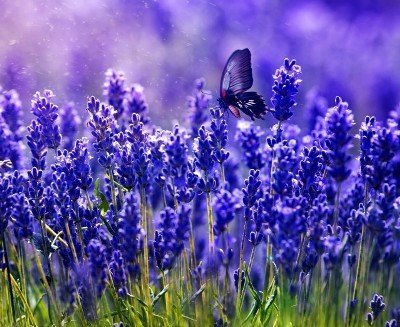

Be careful with nitrogen fertilizers - they affect the development of stems and leaves, while the inflorescences become not lush enough. It is better to feed lavender with potash fertilizers
The simplest breeding method is stem layering. We bend the twig, press it to the ground, sprinkle it and secure it with a load or a hairpin. It takes several months to take root. As soon as the roots have formed, we cut off the layering, and cut the cut for protection with coal.
Valerian - feline joy
A soothing drink on valerian drops is familiar not only to people, our pets - cats and cats of all kinds - happily gnaw on dried roots, for which this amazing plant is called cat grass.


Small, fragrant, pinkish-white flowers of valerian, collected in large inflorescences, are rather background flowers, therefore they will easily fit into any floristic composition, moreover, they bloom throughout the summer, which will only benefit our medicinal flower bed
We sow seeds in July, then a transplant will be required in September. We make shallow grooves in the soil, put the seeds and sprinkle them with nutritious soil, preferably humus.
In about a couple of weeks, shoots will be visible, which, after the appearance of the fourth leaf, we transplant to a permanent place of growth. The soil of the flower bed must also be enriched with humus, dug up and loosened.
Plants that remain on the flowerbed for "wintering" must be fed with nitroammophos or similar fertilizer (containing phosphorus and nitrogen), 50 g per 1m² is enough
If the plants are sown in early spring, then by autumn they will give the first crop of rhizomes, and summer plantings will be useful only next year.
Sage is a versatile healer
In the northern regions, it is preferable to grow winter-hardy and useful varieties - Patriarch Semko, Nectar, Aibolit, Breeze. The listed species are included in the State Register of the Russian Federation and are officially recognized as medicinal.
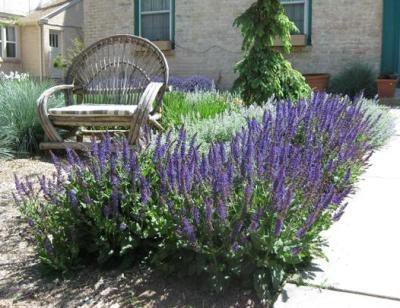

Sage forms tall, lush blue bushes, so when decorating flower beds, the best place will be the central one or at the wall (fence) if the flower bed is adjacent to the fence
For planting, you need a soil of medium acidity (up to 6.5 pH), good lighting. Moderately moist loamy soil is suitable. We use compost, humus and flower potash-nitrogen fertilizers as fertilizers.
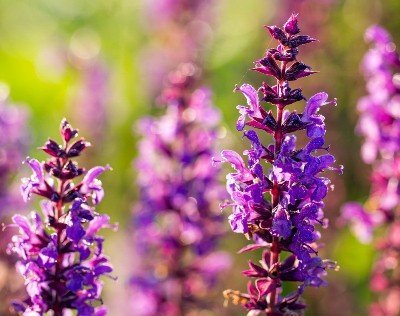

Attention: it is not recommended to sow seeds in areas where sage relatives used to grow. The best option is soil from legumes, potatoes, cabbage, or onions
We plant the seeds in October or early spring, using a nesting method or grooves, at intervals of 25 to 45 cm. We make 2 cm depressions, sprinkle with loose earth. In one place, sage develops for a rather long period - up to 8 years.
Geranium
Geranium blooms until the end of the summer season. The corollas of the plant are short-lived - in just a day, a new one appears instead of a wilted inflorescence. Cut leaves are decorative. In autumn, they are painted in bright colors of different shades, and retain their color until winter.


Geraniums can be up to one meter in height. The smallest species are from 10 centimeters. Undemanding to soil, grow well.
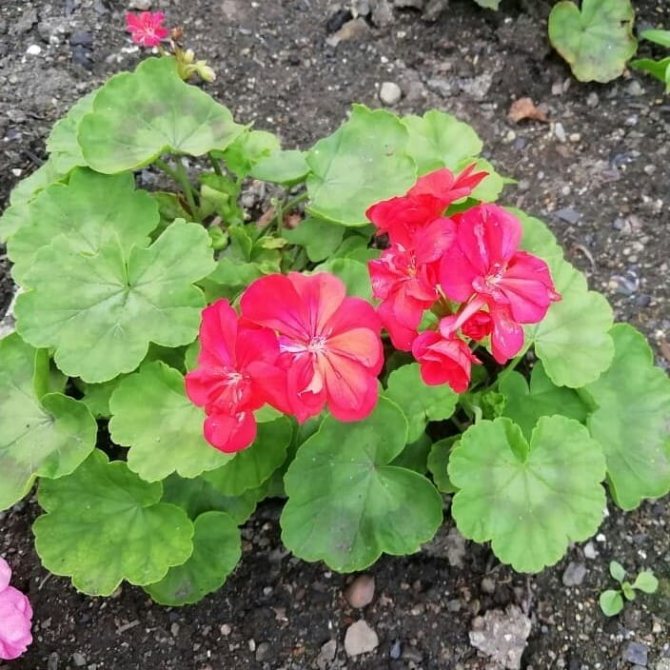

Pharmaceutical flower garden design
Let's start with the fact that the shape and size of medicinal flower beds are no different from ordinary ones. Suppose that you have already picked up several useful plants that differ in height, splendor, shades and size of inflorescences. Our task is to correctly arrange the flower bed itself and arrange the plants on it so that the overall composition looks attractive, and does not resemble spontaneously and randomly planted crops.
The flowerbed can be round, oval, square, rectangular, or elongated along the facade of a house or fence. If it is in the center of the site, combined structures can be used.
The original two-tier design is ideal for creating a medical flower garden: sectors of different shapes can be filled with cultures with inflorescences of different shades, contrasting or related
The idea of raising flower beds is not new - it is with the help of raised structures that you can create magnificent pyramid flower beds. From the technical point of view, such structures also have an advantage: it is convenient to arrange a drainage layer in them for plants that do not like too wet soil.
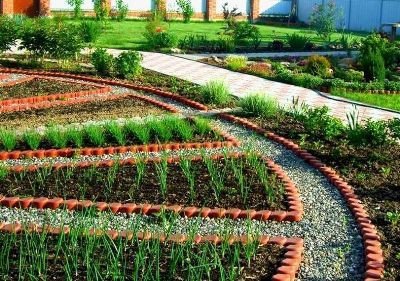

If you are used to working with beds, then you can create an interesting flower bed in the form of a mini-garden: divide a large area into sectors that resemble separate beds, and plant them with flowering crops
Planting plants of the same type is simple, it is much more difficult to compose compositions from different crops within one flower bed. In this case, all the nuances must be taken into account:
- flowering time;
- the height of the stems;
- shape and shade of inflorescences;
- growth activity.
The rest depends only on the imagination of the grower. Let's give an example of a flower bed on which a composition of 12 plants is collected. Of course, it will give little medicinal raw materials, but the decorative effect is excellent.
You can learn more about how to break a beautiful flower garden in front of the house from the material:
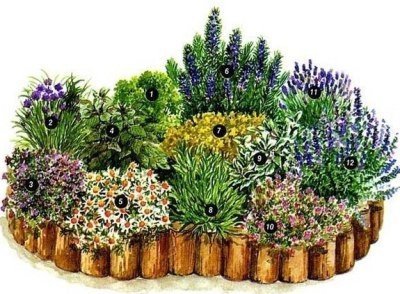

Inhabitants of the flower bed: 1 - parsley; 2- chives; 3 - thyme; 4 - mint; 5 - chamomile; 6 - rosemary; 7 - oregano; 8 - tarragon; 9 - sage; 10 - echinacea; 11 - lavender; 12 - medicinal hyssop
Turkish carnation
The multicolored Turkish carnation opens in June. Bright and colorful, it is able to adequately decorate any flower bed. Grows in small dense inflorescences of various shades.
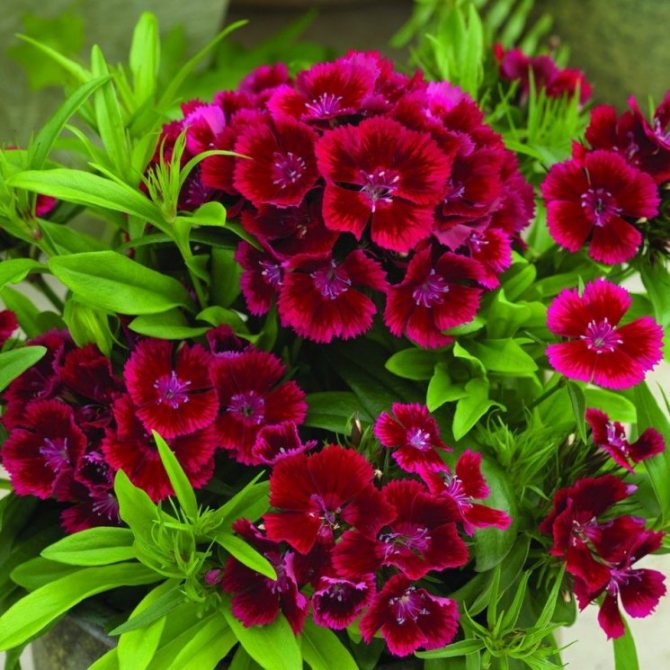

Differs in long flowering, the ability to reproduce independently and a riot of colors. In height, a Turkish carnation reaches 40-60 centimeters, it all depends on the variety. In a well-lit area, it can demonstrate its decorative effect as much as possible.
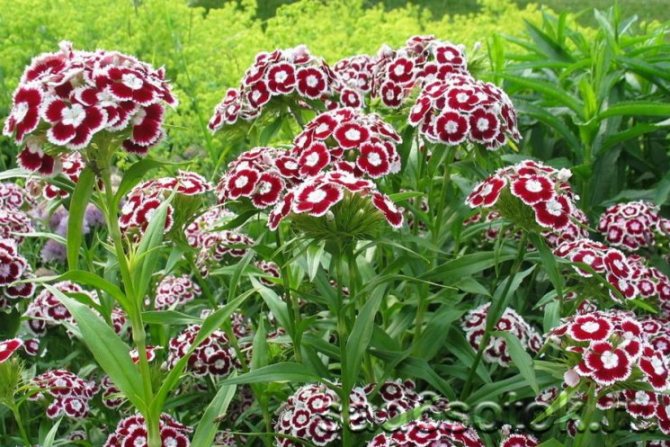

Sorry, the requested page does not exist.
No results were found for this request. Try using the search to find what you need!
What can be done?
- Use search
- Go to the home page.
You may also be interested in
Processing 0
Why does garlic turn blue when pickling tomatoes and cucumbers when preserving other vegetables
Causes of blue discoloration In search of an answer to the question of why garlic turns blue in the marinade,
Plants 0
Why are light green leaves in grapes
Grape leaves turn yellow - what to do? If you find yellowed leaves on grapes,
Processing 0
Why do cucumber leaves turn yellow than to process and spray how to treat
Why do the edges of the leaves turn yellow in cucumbers, what to do
Landing 0
Large-fruited garden strawberries: varieties with photos for Siberia, for the Urals, for the Moscow region and Udmurtia and reviews about them
Strawberry varieties for the Urals There are a large number of varieties of this berry, today they
Content 0
Hoya varieties
Planting homemade hoya cuttings and caring for the plant Among the variety of indoor plants, special attention


Cropping 0
Babachny hawk - methods of detection on tomatoes and methods of struggle video
What is the danger The small white fly in the garden is a representative of the whitefly. It is very petite
Plants 0
Tomato Champion f1: characteristics and description of the variety with photo
Agrotechnics The optimal planting scheme for these tomatoes is 40x45-50 cm, for 1 m2 it turns out four


Landing 0
Blackberry propagation by cuttings time of harvesting planting material video
The main methods of reproduction Blackberry propagation is possible in several ways: Division of the bush; Seed method; Green cuttings;
Growing 0
Description and characteristics of the Krassen grape variety breeding history and cultivation features
History of appearance The author of this species is V.V. Zagorulko, breeder from Ukraine. Experienced crossed
Cropping 0
The best varieties of tomatoes with photos and descriptions of 60 varieties
I. Hybrids Hybrid tomatoes are practically guaranteed resistance to diseases and bad weather than
Landing 0
Apple tree Columnar currency: variety description, planting and care
The history of the emergence of compact apple trees Almost 50 years ago, a Canadian gardener discovered a tree that has
Growing 0
Leeks: growing from seeds at home
Types and varieties of leeksAttention and accuracy when growing seedlings of leeks are necessary to create
Greenhouse 0
Siderata for tomatoes greenhouse and open field planting alternative replacement
Advantages and disadvantages of planting siderates These siderates are used when growing tomatoes (click to enlarge)
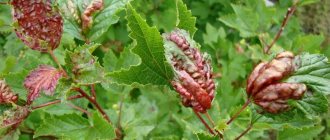

Diseases 0
Currant anthracnose treatment of the disease with drugs and folk remedies
What is currant anthracnose? Causes of the defeat of garden currants with anthracnose, symptoms indicating the appearance
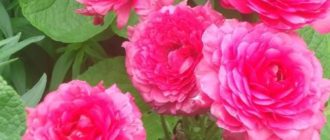

Landing 0
Ranunculus - planting and care in the open field in spring in Siberia when to dig video
Varieties and description of ranunculus We will not consider all 600 species - we will focus on the most
Breeding 0
Cherry Morozovka description and characteristics of the variety, yield and pollinators
Protection against diseases and pests To keep trees healthy, you must carefully inspect the trunk,
Cropping 0
Hawthorn compote and jam benefits and harms
Harm of hawthorn to health Drinks from berry crops were often used for medicinal purposes in the past,
Landing 0
Description of Krasnostop grapes and specific characteristics of planting and care rules
Planting and caring for grapes Choosing a site for planting grapes should be taken seriously.
Landing 0
Perennial Gaillardia: planting and care in the open field, photo, growing from seeds, types and varieties
Sowing and seedling Growing a flower does not require special conditions and efforts. The plant is thermophilic, good
Growing 0
Apple tree Sokolovskoye description and characteristics of the variety, yield and winter hardiness
Basic information about the apple tree The apple tree is an unpretentious tree and bears fruit even in the most frosty regions. Growing
Photo of the best flowers for a summer residence
Please repost
2+
2
When to plant plants in a pond
The best time to plant is late spring and early summer. However, you can replant and add new inhabitants to the pond throughout the summer. Fresh water must definitely settle (at least 8-10 days) and warm up well.
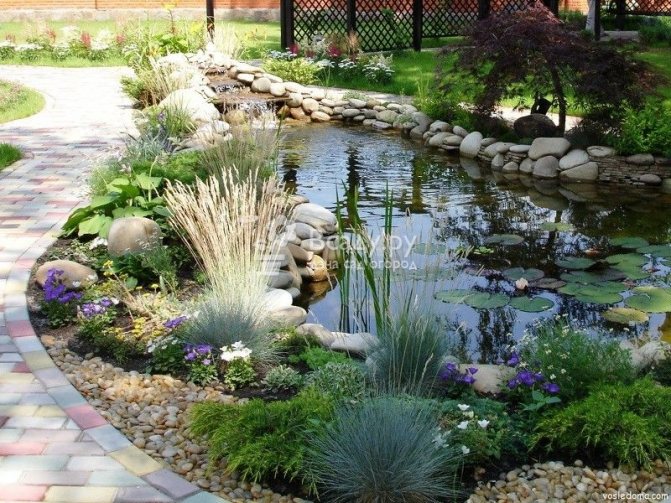

Aquatic and coastal plants make the pond unique and eye-catching
Planning landing
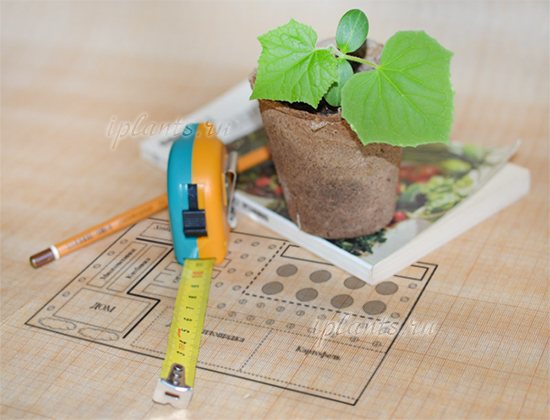

- Draw a plan of your site on graph paper, to scale. Format is not less than A3. No need to sketch it freehand on your knee, take accurate measurements. You will need a tape measure and an assistant.
- Mark on the plot diagram all buildings that are available and planned: a house, a barn, utility rooms, a swing, a gazebo, a barbecue area or a pool, all flower beds, a compost heap. We mark separately the vineyard (if there is one or is planned).
- Make a copy of the site plan, for example, on tracing paper, or redraw, photocopy, as there may be several options.
- On the entire space free from buildings and flower beds, select zones according to illumination: the sunniest and shady places.To do this, spend a day and take a close look at where the shadows from trees and buildings fall.
- Note the source of the water.
- Choose places where you can put greenhouses or a greenhouse - these are the widest areas. Consider track and row spacing. The passage for a wheelbarrow should be at least 50-60 cm, the larger the area, the greater the width of the tracks you can afford. But if the plot is small, it all depends on your appetite: are you willing to get by with 30-centimeter passages between the beds, or you need more to turn around during weeding.
- If you have compiled a large list of planned plantings in the garden, it is better to make more narrow beds of 45-60 cm than wide meter beds.
Garden plot
Probably, every person who has his own personal plot dreams of a beautiful and productive garden. In order for this to become possible, it will take a lot of effort. It would seem, what's the difference, how are the trees in the garden? However, it turns out that garden planning is the very first step from which everything starts.


A garden is a place where there should always be plenty of sunshine. Almost all fruit trees love light and warmth. Slopes (6-8 degrees) are good for the garden, much better than completely flat areas. The upper 2/3 of the slope are especially good for the garden, at the very bottom it is better to have berry bushes. The only exception is the southern slopes - their trees are not very fond of. It is especially dangerous to plant a garden in forest glades - in such places the outflow of cold air is very difficult and the trees will feel very uncomfortable.
Garden flowers care
It is best to plant flowers and plants in the country that do not need special care, and for this you just need to adhere to the rules:
- location in the right place, that is, light-loving flowers should grow under the sun, and only a rare hit on shade-tolerant ones,
- during flowering, remove wilted leaves in a timely manner, thereby you will extend the flowering period,
- when buying, find out the number of blooms per year, some plants should be cut for this.
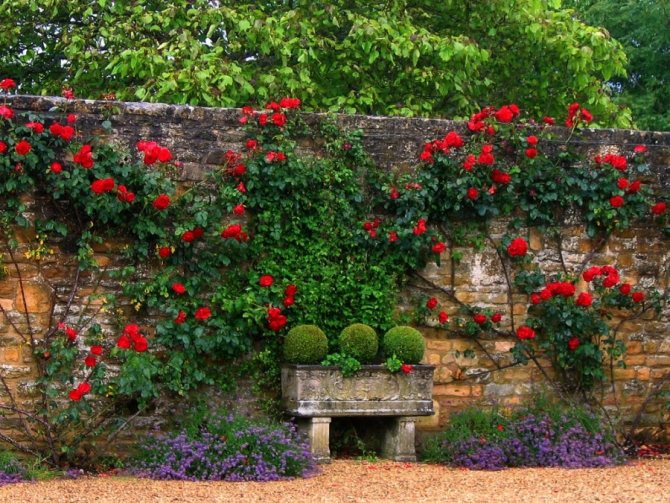

For the correct and beautiful design of the site, you can use:
- rabatku - wide stripes of different colors, planted along the paths,
- curbs - narrow strips of low-height plants,
- arabesques - floral patterns in the Arabic style, a very complex process of creation,
- array, combinations of a huge number of flowers of different shapes and varieties,
- solitaire, a free-standing arrangement of large perennial flowers,
- plant plastic is a very painstaking process, for its creation requires a frame on which the flower carpet is grown.
You can make your summer cottage colorful and unforgettable on your own and at minimal cost. But their amazing and attractive appearance will delight you and those around you for a long time.
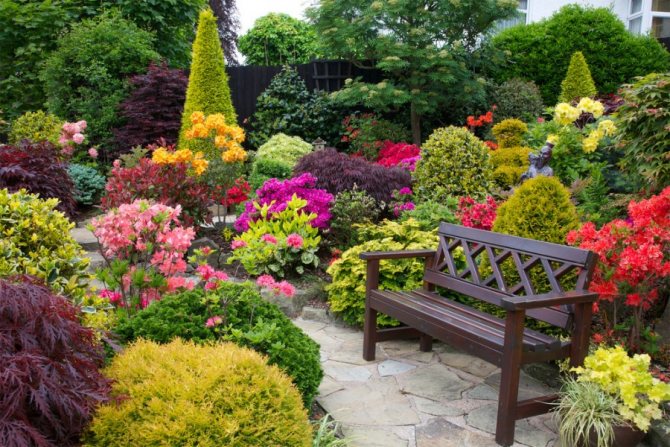

What vegetables can be planted in the country
In summer, summer residents want to harvest as large a harvest of vegetables as possible in order to get enough vitamins for a whole year, and even leave them for conservation. If we talk about tomatoes or cucumbers, then these plants require increased attention and care.
Vegetables in the country
Often they have to equip greenhouses for them. But vegetables such as beets, radishes, peppers, carrots, eggplants, zucchini, pumpkin, cabbage and broccoli are quite possible to grow in the country without much effort. If you have the desire and strength, then you can plant potatoes in the garden. And you can enjoy tasty and healthy melons and watermelons if you find a suitable place for them in your country house. These crops are also not picky to care for, so they can give a decent harvest with minimal watering and loosening of the soil.
What is the advantage of perennials
Many growers believe that among perennials there are no brightly flowering plants all summer long. This is completely wrong judgment.We will try to prove it. But first, let's find out why it is better to grow perennial plants in the country or in the garden.
Important advantages:
- Having planted flowers once, you can admire the flowering plants for several years in a row, without worrying about planting.
- Perennials have a long flowering period, usually from May to the first frost.
- Such plants are less sick, they tolerate drought and frost, so many of them are grown even by Siberians.
- You can plant perennials that bloom all summer anywhere, the plants are not too demanding on lighting, soil, watering and weeding.
- The decorative qualities of perennials are not lost all summer.
- Having created a flower arrangement when planting flowers once, you do not have to spend money on buying seeds, growing seedlings every year. The right plants will bloom all summer long.
Attention! The varietal variety of perennials surprises even the most experienced gardeners.
For example, there are several hundred species of liliaceae.
Beautiful perennials in the country - video tour:
Perennials that bloom all summer long in the country reproduce:
- bulbs;
- roots;
- seeds.
Look at the photo, what an amazing flower arrangement that resembles a river.
How to arrange trees correctly
So far, we are only planning the place of the future orchard. Many people make the mistake of planting fruit trees the very first of all plantings, guided by the incorrect logic that "they need the most time to grow."
On the contrary, fruit trees, as the most difficult garden object, are planted last. And this is not only because the place for them should be chosen in the most balanced way, but also because the land should be the best in composition, and it takes time to prepare it. Fruit trees are not planted in acidic soil, and deoxidation will take at least 1–2 years.
How to choose a place for an orchard on a vast plot of 10–20 hectares or more, where, in addition to a not-so-spacious sunny front garden, there may be other suitable places for fruit trees?
There is a clear rule: fruit trees should not be located in the lower part of the site, despite the fact that there will be better water supply for them with groundwater. The factor of damage to flowers in spring frosts, as well as in winter frosts, turns out to be more important for the Middle Lane. In a low place, cold air accumulates, it is always colder there by a few degrees than near a high place.
For fruit trees, the morning sun is much more valuable than the evening sun. Hence, let your future garden be better lit from the east than from the west. Try to plan the site so that nothing blocks the morning sun from your best trees.
In addition, for the orchard, they try, if possible, to choose such a place so that “behind” the trees, on the northern side, would be protected from winter cold winds. In a cottage community, this factor is removed by itself, the winds are extinguished there by buildings and high hedges, but in an open area, for example, on the shore of a lake or a wide river, it can be of decisive importance.
On a fairly large area, in the presence of wind protection, fruit trees are best planted in a row or in two rows along the entire northern side (or, say, an angle on the north and west sides). This is done so that they do not block the sun from the rest of the plantings, mainly the vegetable garden.
To the content
Perennials for giving: the nuances of breeding
Consider the features and benefits of perennial plants. As already mentioned, perennials for summer cottages are a very profitable solution. In addition to saving on seedlings, if a frost-resistant species is chosen, they can reduce labor costs, saving gardeners from the annual planting of flowers. The main thing is not to be mistaken with the choice of a place for them and to provide proper care.
All perennials can be divided into two main groups:
- Plants resistant to temperature extremes and overwintering in the ground.
- Requiring digging and transferring to storage during the winter.
Perennials are good for giving
The first group includes peonies, lilies of the valley, delphiniums, lupins, phloxes, Turkish carnations and others. The second includes gladioli, dahlias, begonias, hyacinths. Naturally, the maintenance of flowers that require wintering indoors will be more troublesome and, when making a choice, this must also be taken into account.
Perennials are very diverse, so it will not be difficult to choose plants that are optimal for your site. If you decide to equip a flower bed of several varieties of perennial flowers, it is worth planning their location in advance, taking into account the height of the plants and how they are combined with each other.
The tallest flowers, as a rule, are planted in the center of the composition, and medium-sized and low-growing ones are placed around them. It is better to choose species that bloom in the same period in the most harmonious color scheme, or, conversely, play in contrast.
Advice! If you want a flowerbed with perennials to always look fresh and interesting, you should leave space on it for annuals, which can be updated annually.
About crops and varieties
Now many people prefer fruit trees on dwarf rootstocks or generally columnar. This is the right solution, perfect for any private garden.
A small tree, reaching two meters, or in general a column, like a large thick stick with leaves and fruits, takes up a minimum of space, quickly begins to bear fruit and delights you with fruits.
There is, however, one "but" - any fruit crops sometimes require very serious treatments with harmful drugs, so try to plant even small trees away from shrubs, the fruits of which ripen much earlier. Step back 5-6 meters and then the treatments will be safer, especially if you choose calm weather for them and do not exceed the recommended dose.
Sea buckthorn family
Sea buckthorn is most often planted as a family - one male plant (in the center) and one more along the edges. Sea buckthorn can be planted both in autumn and spring, highlighting the middle of the site for them - in front of the apple tree, but behind the bushes. From sea buckthorn, you can recommend the old proven variety - "Amber Berry".
OUR REFERENCE
If the site is so small, "decorates" a gigantic fence three or more meters high, then it is better not to plant anything at all next to it, the shadow from the fence will be corresponding to its height, but if the site is fenced with a hedge reaching a meter height, then boldly, departing from it a meter and a half, you can plant any plants.
Try to plant a couple of apples of the same variety, but you should not be too zealous.
If you want to plant other fruit trees, it is better to plant no more than three apple trees of different varieties, two or three meters away from one another ..
Rules for the selection and planting of perennial plants for the garden and summer cottages
In order for the planted plants to create a harmonious picture as quickly as possible, it is necessary to adhere to the rules for the selection and planting of perennial species for the garden and summer cottages. The main recommendations of gardeners:
- Varieties and types of crops are selected in accordance with the climatic conditions of the region
- The type and composition of the soil, the amount of moisture and light are taken into account
- It is necessary to measure the acidity of the soil
- The depth of groundwater is set
- Necessarily provides for the correct neighborhood of both fruit and ornamental plants
- Keeping the distance between trees and shrubs
- The terrain is carefully studied
- It is important to consider the presence of underground communication highways
You also need to consider the planning style. When building a summer house, three main types are usually used:
- Geometric
- Picturesque
- Mixed
Garden landscaping
In the geometric style, perennials with dense foliage and a rapidly growing aerial part are used.
It is easy for such plants to give a clear geometric shape that will harmoniously look with even beds, small buildings and narrow paths.
Trees and shrubs are planted in the form of a square, rectangle or staggered. The paths are fenced off with rectilinear figures. The straightness and symmetry of the landings with this style emphasizes the main axis of the geometric shape of the site.
Multiple species of all perennial crops are suitable for a picturesque design style. Low-growing and grassy crops will be appropriate for the design of slides, winding narrow paths and artificial oases.
Stronger perennials are planted near artificial or natural heights and water bodies. Thus, their irregular shape is emphasized, which makes the site unique.
The mixed style is most often used when setting up a garden or decorating a garden plot. It includes elements of geometric and pictorial style.
Suitable for both landscaping a site with existing plants and buildings, and when planning a planting scheme in an unplanned area.
Regardless of the types of selected perennial plants for the garden and suburban area, it is recommended to plant them in a tiered order. This arrangement allows plants to receive enough light, which significantly affects their appearance.
Garden schemes
- Quadratic is equal rows of trees. With such a planting, it will be very convenient to work in the garden.
- Staggered planting order - trees are arranged more densely than in the previous case. There is a tree in the center of each square.
- The triangular pattern is an even denser pattern and is used for trees with large crowns.
- The horizontal arrangement of trees is when there is a slope on the site and trees will be planted along it in ledges.
It is very important that sufficient space is allocated for each tree in the garden. The tree will not always be small, someday it will turn into a sprawling full-fledged plant. In order for the trees not to interfere with each other in the future, each tree should have 4 square meters. land.
The queen of flowers in landscape compositions
Roses are one of the finest and most popular flowers in the garden. How to correctly combine roses with other plants, not minimizing, but emphasizing their beauty?
Here are some tips for creating a composition featuring the queen of flowers:
- When planting, it is better to surround flowers not with other flowers, but with greenery, which will create the desired background without distracting attention to itself.
- Planting several varieties of roses next to it is wrong. It is better to surround it with more modest neighbors or to place many plants of the same variety nearby.
- Large flowering shrubs should not be planted next to the rose, they will distract attention. The best option is a small bush with silvery leaves.
- Roses look good next to evergreens. Among them, it is better to choose low spruce, fir, pine. Roses in such a composition are soloed, the needles give the flower a special sophistication, exclusivity, serves as a wonderful background, emphasizing its rare beauty favorably.
- In the vicinity of box trees, the rose looks like a highlight. This combination is very common in European rose gardens, and box trees are given the most diverse forms. For the winter, this shrub must be wrapped along with rose bushes, because he does not like low temperatures.
Drawing up landscape compositions is a whole science, which includes floristry, color, allelopathy, agrochemistry, aesthetics and others. We recommend reading the article on the prairie garden.


Here you need to take into account the comparability of plants for various characteristics - compatibility, size, color, shape, growth and flowering conditions.
But a living picture should still please with a change of colors, create a positive mood, help to relax and unwind.
And combinations of plant smells should not cause allergies and headaches.
Therefore, landscape design, taking into account all these and many other features of wildlife, is so important for everyone. You can read the article about the features of the country-style site design.
How to choose the right place for perennial crops in the garden
A properly composed composition allows you to make the landscape of the site not only colorful, but also harmonious. All plants should balance each other, and emphasize the brightness and vibrancy of neighboring crops.
When planning a planting scheme, it is necessary to take into account the landscape of the area and the presence of various buildings. Particular attention is paid to:
- Terraces
- Fountain or pond
- Flower beds
- Monolithic fences
- Garden paths
Small perennial flowers
Terraces are a small paved area next to the living quarters, which is fenced with metal or wood gratings.
To add coziness and freshness, the hedge is decorated with ornamental shrubs or climbing herbaceous crops.
It is recommended to plant moisture-loving crops near an artificial reservoir. But it is important to consider that many of them grow quickly, so you need to constantly prune them.
Large bushes lend an abandoned look to this landscape decoration. It is also not recommended to stir tall deciduous trees near the pond. They will constantly pollute the pond with fallen leaves.
Herbaceous low-growing perennials are suitable for decorating flower beds. Flower crops with bright buds look spectacular.
It is recommended to plant lianas, shrubs or tall herbaceous crops along high, non-ventilated fences and structures. It is important with such a planting to take into account the frost resistance of the culture. It should be tall.
Paths on the site are laid at the last moment. They are located in the place of well-trodden paths. This layout avoids damage to the lawn.
Evergreen, fruit and ornamental shrubs are used to fence the paths. The use of herbaceous and floral crops is also acceptable. To make it look natural, it is allowed to sow lawn grass on stone paths.
Of course, in the first year after planting all the plants, it is not always possible to obtain the desired greening effect. After all, plants need time to grow and get stronger.
But if they are selected correctly, after a couple of years the site will shine with bright colors of fresh greenery.
Types of perennial plants for the garden and summer cottages
Perennials are often used in outdoor landscaping. These crops are popular with gardeners and amateur gardeners.
With their help, you can not only give originality to the yard, but also emphasize its individuality. Also, by planting fruit and fruit crops, you can get a harvest of fresh fruits and berries.
Decorating the garden with perennial plants
The category of perennials includes all plants that live for more than two years. The described plants for the garden and for the dacha include:
- Trees
- Shrubs
- Herbaceous plant
Trees and shrubs have a stiff aerial part.
In herbaceous perennial crops, the aboveground part does not grow stiff. In the winter season, the stems completely die off, only the underground part and surface buds on the aboveground shoots are preserved.
Also, all perennial varieties are subdivided into several additional subgroups:
- Monocarpic. The culture blooms and bears fruit once for the entire period of development. Usually this process takes place in the last year of the plant's life.
- Polycarpicus. These plants bloom and bear fruit many times throughout their life. Usually this process is cyclical and repeats from season to season.
- Deciduous. In crops of this subspecies, with the onset of the cold season, foliage dies off. The leaves gradually fall off. Until the branches are completely exposed. Starting in spring, new foliage forms on the plants.
- Evergreens. A characteristic feature of these plants is the preservation of foliage and its rich color throughout the year.
All categories contain not only fruit, but also decorative crops. Therefore, when planting, it is important to create the most favorable conditions for each plant.
For this, special schemes for planting plants and combinations of their placement throughout the site are being developed.
Play of color on the site (20 photos)
Unpretentious flowers for a summer residence - a solution for novice gardeners
Of course, not everyone can visit the country every day and spend a lot of time caring for flowers. But what if you still want to decorate the site? In this situation, unpretentious flowers for a summer residence will come to the rescue, which even a novice gardener can handle.
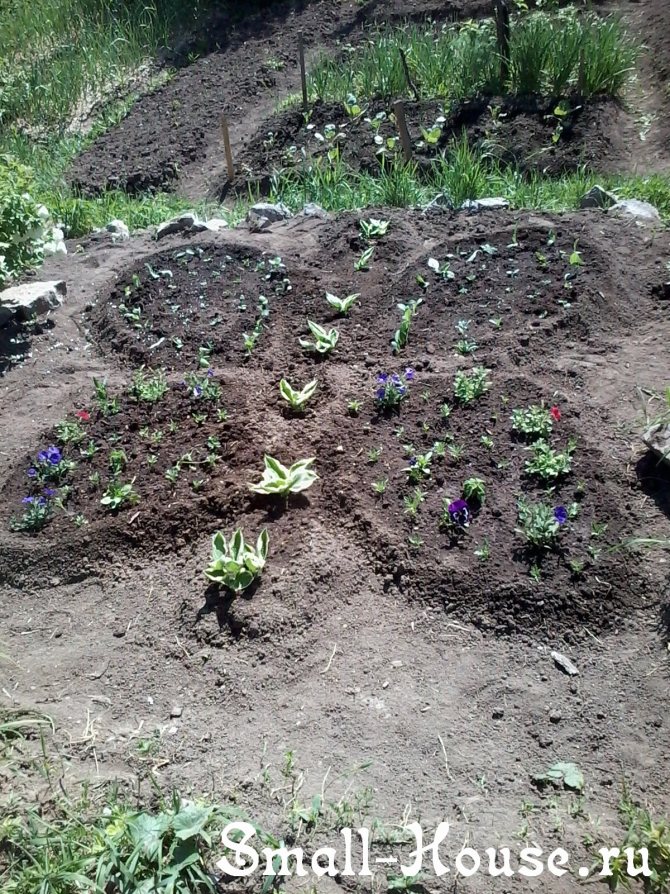

A flower bed in the shape of a butterfly will delight you all summer!
It is advisable to choose species that tolerate heat well, are undemanding to the composition of the soil, are little susceptible to various diseases and are not particularly attractive to pests. Among low and medium-sized flowers, marigolds are quite consistent with all of the listed criteria. They always look appropriate and, thanks to their bright colors, are able to revive even the most nondescript corner of the summer cottage.
Also unpretentious in care and calendula. This sunny orange flower can not only decorate your garden, but is also a medicinal plant. In addition, she can delight you with her flowers until October-November.
Lawn of poppies and cornflowers
Another interesting solution is a lawn of poppies or cornflowers. They will not require special care, but will look luxurious. Such a flower meadow will give a feeling of closeness to nature and create the illusion of a small home meadow.
Why are annual flowers good?
Plants that only live for one season can of course be more troublesome to plant them annually, but they also have benefits. Annual flowers do not have to be prepared for wintering and there will be many times more opportunities for experimenting with flower beds. In addition, their distinctive feature, pleasing the owners of the dacha, is a longer flowering period than most perennials.
Annual flowers always look fresh
Usually, seeds are sown in the ground, less often, pre-prepared seedlings are planted. Some varieties release their first buds as early as May and continue to bloom until mid-autumn. A large selection of varieties of annuals, from very small to luxurious and curly liana-like, opens up ample opportunities for landscape design.
The smallest of them, such as lobelia, purslane, undersized marigolds, dwarf phlox and escholzia, are great for decorating alpine slides and garden paths. Varieties that can branch and grow well are very popular, for example, petunia and castor oil plant.
Curly species are also in demand. They are especially relevant for owners of plots with gazebos and fences made of chain-link mesh. The most common of these are imopea, dolichos, kobea and sweet peas. They grow very quickly, and the rich color palette of their buds will transform and decorate your summer cottage until the coldest days.
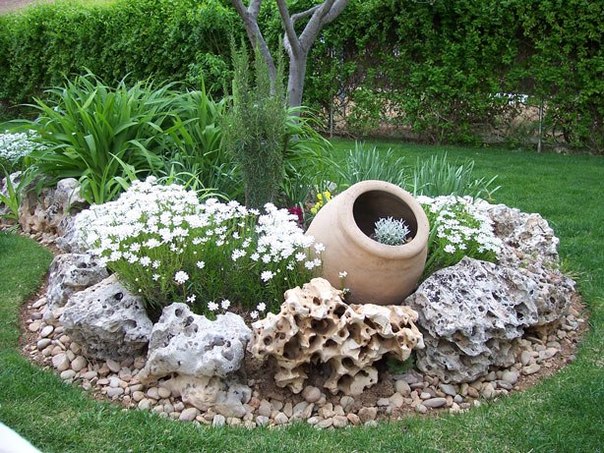

Interesting flower bed design
Landing rules
- A plan of a flower bed is drawn up
- The place of perennials of different heights is marked.
- A group of plants is selected specifically for curbs and planting along garden paths.
- The colors and the timing of the blooming of flowers are taken into account so that you have plants that bloom all summer.
Important! When planting perennials, consider whether the flowers will be in harmony with each other.
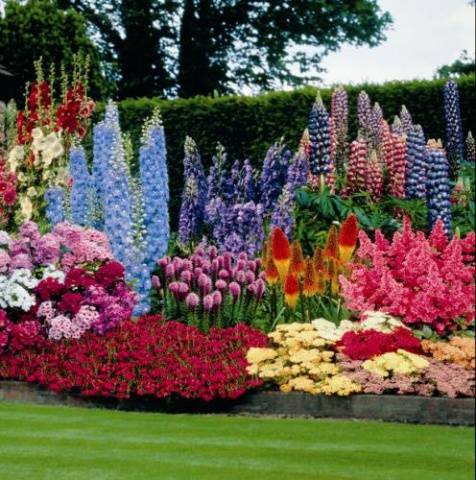

Compatibility of trees and shrubs
- Shrubs should be located away from apples, pears, and plums, as the trees will grow and shade the berries.
- Apricot is an independent plant, does not tolerate neighborhood.
- Sweet cherry is adjacent to cherry or apple tree.
- It is not recommended to plant other trees near the apple tree, raspberries can be placed near a young seedling, these plants will develop well together. After the tree has grown, the raspberries are moved to another location. A plum or a pear can be placed at a distance.
- The pear has good compatibility with currants, and mountain ash, an apple tree can be placed at a distance of 5 meters. You can plant different types of pears nearby.
- Plum and sweet cherry, apple tree, pear tree can be good neighbors of cherry, berries do not take root well near such a tree.
- Plum can be located near the apple tree, and currants grow well next to this tree.
- The currant does not grow under tall trees, as the bush is picky about sunlight.
- Black currants and gooseberries are placed at a distance. And red currants are well adjacent to such a berry.
- Gooseberries can be planted close to plums or pears so that the tree does not cover the shrub and it receives enough heat.
- The grape is compatible with almost all fruit trees.
By observing the correct neighborhood of trees and shrubs, you can attract pollinators and get a rich harvest. The choice of seedlings depends on personal preference for the required fruits.
From east to west
Let's go back to our site, to what and how it is better to place here. First, decide on the cardinal points.
Where the sun rises is east, where it sets - west, which means that it will shine in the east-south-west direction, and the north will be in the shade, this must be borne in mind when planting large plants. Do not try to plant trees and powerful shrubs - such as sea buckthorn or irgi on the south side - they can, overgrowing, shade most of the site.
Try to give the southern side to less tall plants. Start, for example, with a bed of strawberries, then plant honeysuckle, currants, gooseberries, and give the boundaries of the plot for fruit crops.
OUR ADVICE
No plot will do without raspberries and strawberries, and if you also want to surprise your neighbors, then plant chaenomeles, dogwood, gumi, chokeberry and dilute all this edible variety with decorative barberry, the fruit of which can also be eaten.
Where to plant bushes with berries
Pragmatically speaking, in the case of living outside the city, the berry is more important than the orchard. This is so if only because the annual yield from berry bushes is much more stable than the "jumping", irregular fruiting of pome and stone fruits.
In addition, berry crops correctly selected for the timing of fruiting provide us with fresh berries throughout the season from June to October inclusive, and this is not to mention their greater variety. Ease of storage until the next harvest in frozen form is another advantage of the berries. Hence the conclusion: allocate the total area under the berry more significant than under fruit trees.
The berry has slightly less light requirements than the orchard and vegetable garden, but still strawberries, raspberries, currants and other berries are sweeter in the sun.
Most often, berry bushes are scattered over the free areas of the site. By types the following winning options are possible.
- Strawberries are allowed to change with garden crops.
- Raspberry trees are planted "undergrowth" near apple trees.
- Grapes are often planted on the sunny side of a building.
- Fences and gazebos are covered with actinidia and lemongrass.
- Sea buckthorn, black chokeberry, hawthorn, mountain ash can be used as a trimmed hedge.
To the content

